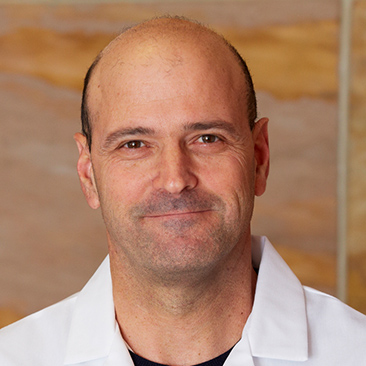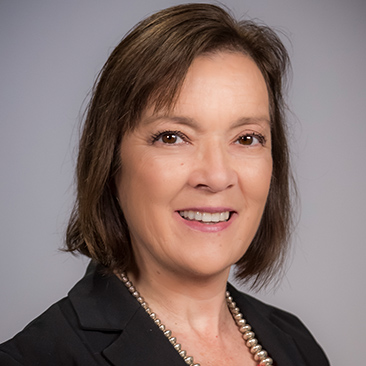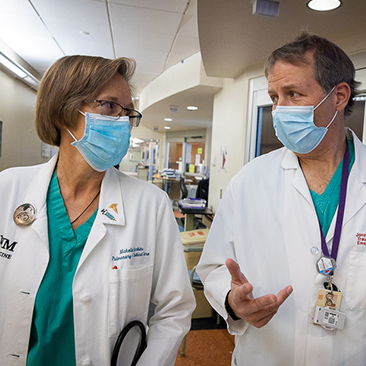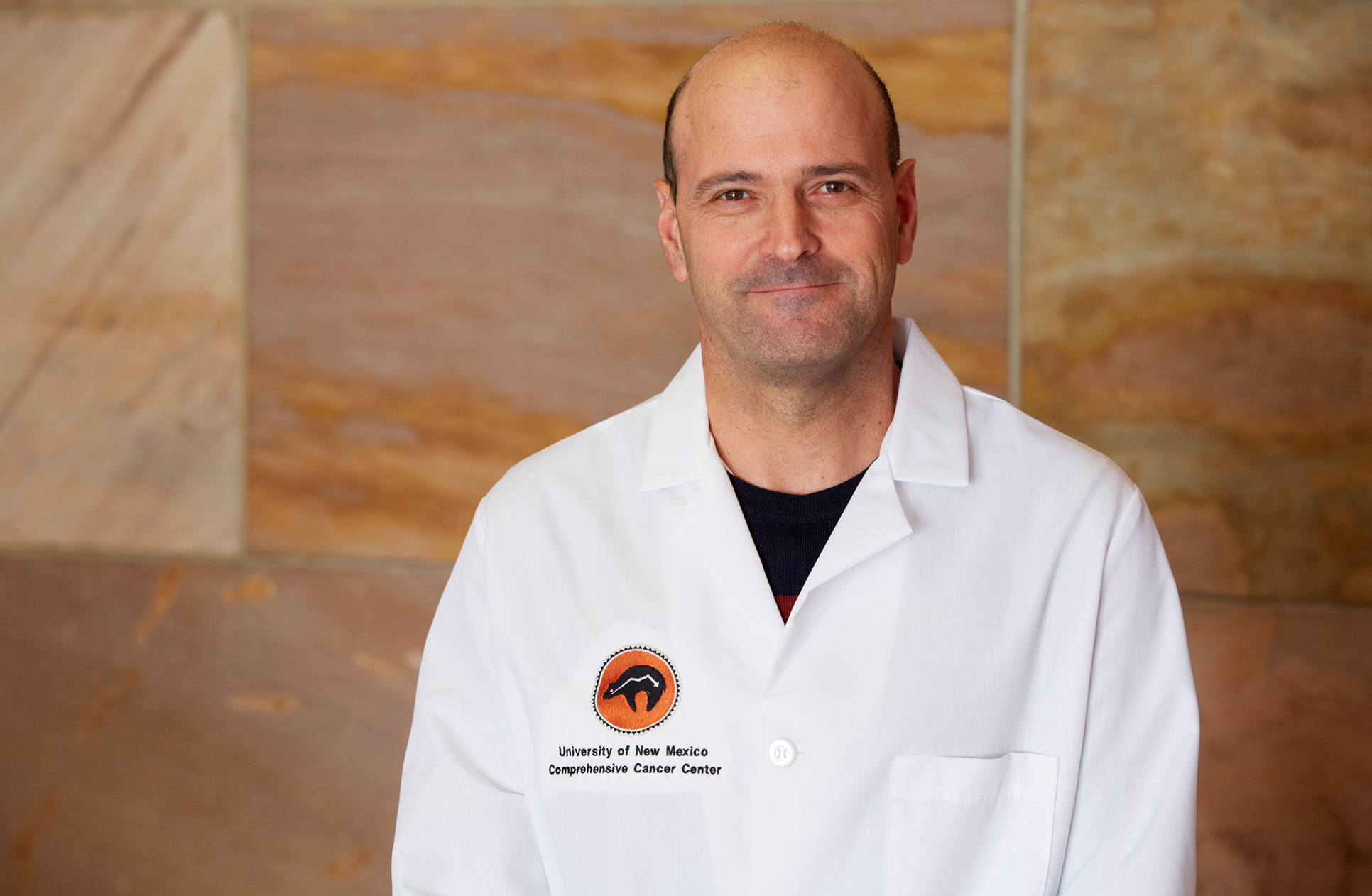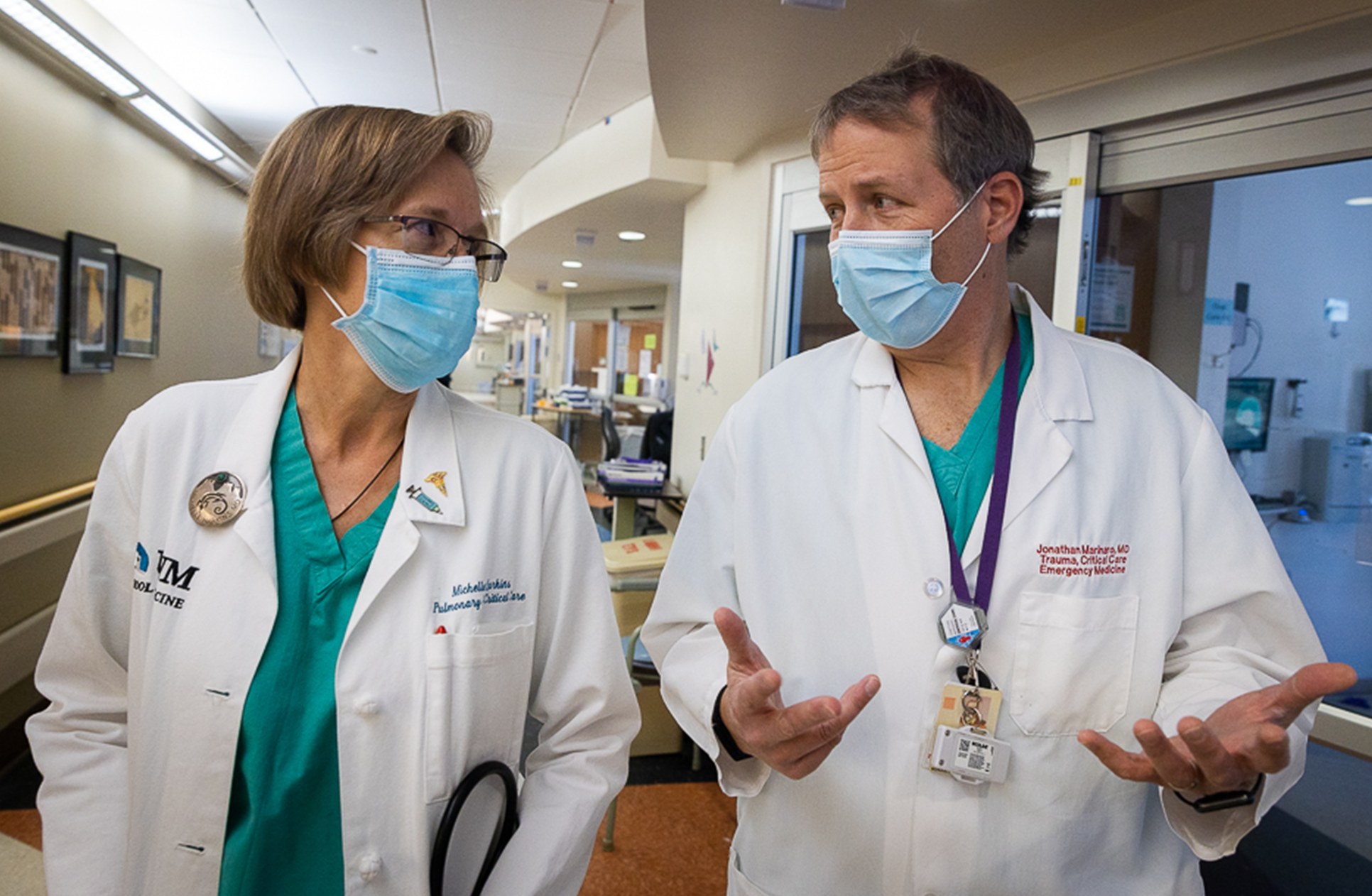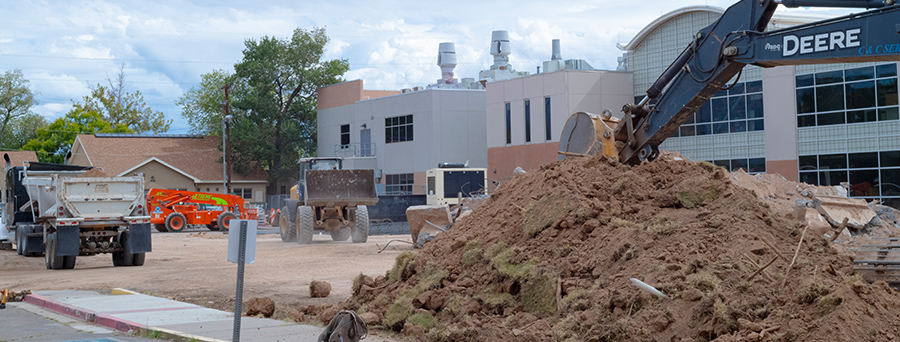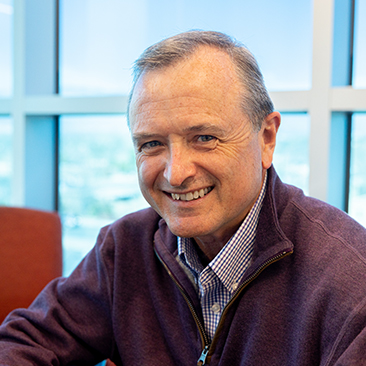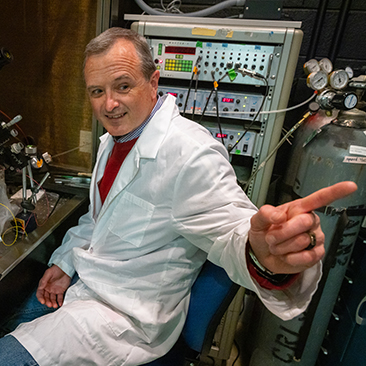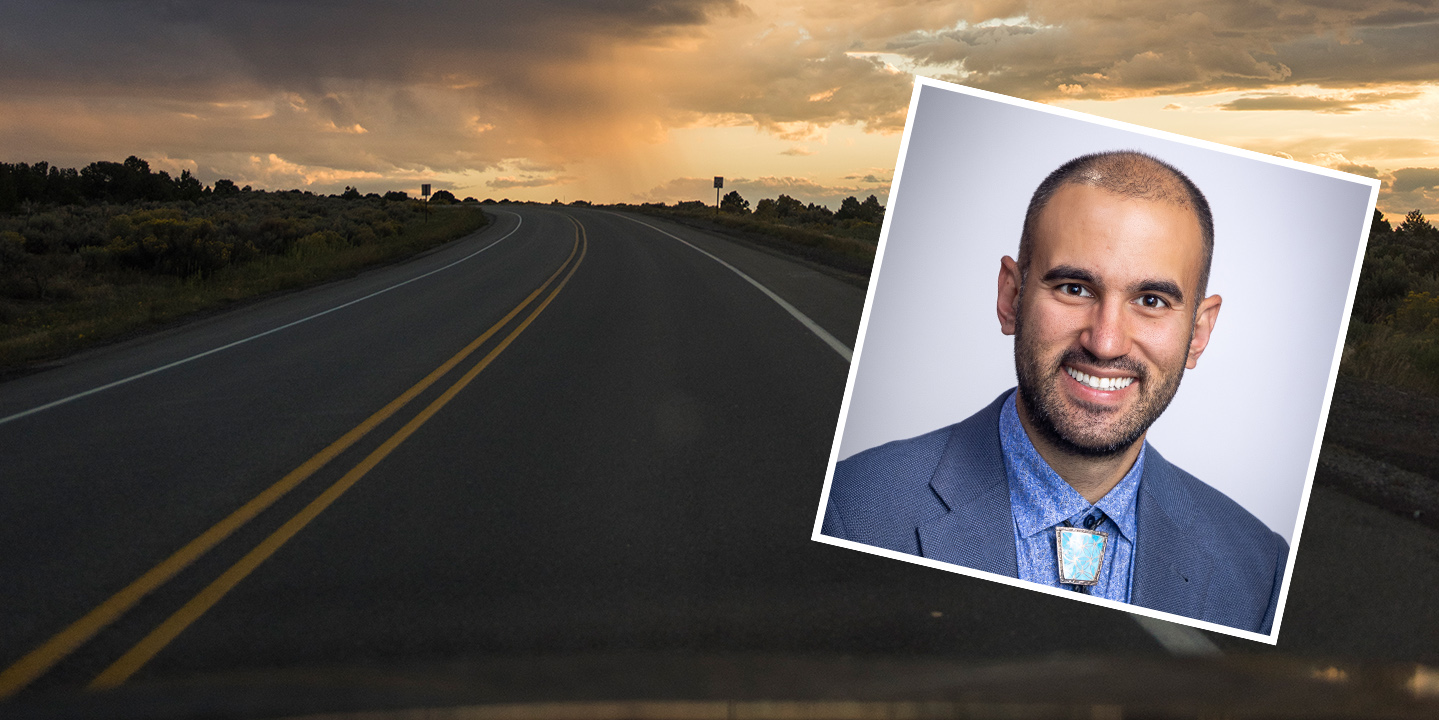UNM Medicine
THE UNIVERSITY OF NEW MEXICO SCHOOL OF MEDICINE ALUMNI MAGAZINE
Fall 2022 edition
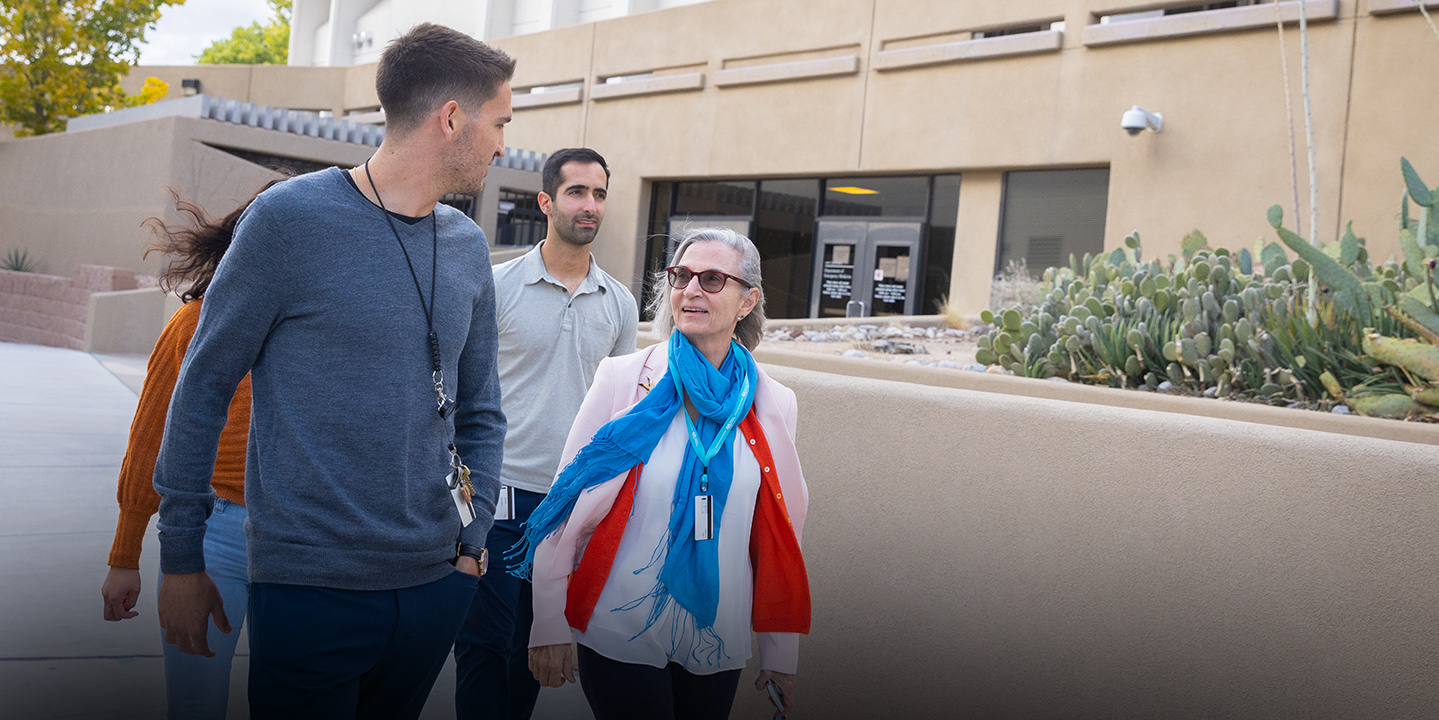
COVER STORY: Constant Commitment
Patricia Finn Brings Health Equity Front and Center in her New Role as Dean
READ
MORE
CLOSE
COVER STORY: Constant Commitment
By Michael Haederle
Patricia Finn Brings Health Equity Front and Center in her New Role as Dean
Patricia Finn, MD, has lived on both coasts and, before moving to Albuquerque last summer, in Chicago. Freshly settled in the Sandia Mountain foothills, the new dean of the School of Medicine recently found herself transfixed by the sight of a double rainbow.
“I felt as though it was a sign that I had really arrived at home,” she says.
Since starting in her new role Sept. 1 Finn has been taking stock of her new surroundings and shaping her vision for the future.
"Because I am brand new, because I am newly arrived, I can ask anybody anything,” she says.
She pronounces her new colleagues “completely awesome” due to their dedication to patient care. “You cannot clone that,” she says. “I feel really lucky, because I see this altruistic group committed to doing the right thing.”
Michael E. Richards, MD, MPA, Senior Vice President of Clinical Affairs, who served as interim dean before Finn’s arrival, says her depth of experience is proving invaluable. “The big challenge for Dr. Finn is that she’s coming in the aftermath of significant disruptions in health care, including the pandemic and a surge in patient volumes,” he says. “She brings an approach to managing the School of Medicine that fits New Mexico and us really well.”
Most recently, Finn was head of the Department of Medicine, associate dean for Strategic Initiatives and associate program director for the Medical Scientist Training Program at the University of Illinois at Chicago, where her husband, David Perkins, MD, PhD, led the kidney transplant program. He has joined the UNM Department of Internal Medicine and co-leads the MD/PhD program in the School of Medicine.
Finn sees similarities between the two institutions. Both were safety net hospitals at state universities whose predominant patient populations were underserved and understudied.
But she’s also attuned to New Mexico’s unique status as a frontier state with significant health disparities.
“In New Mexico we have the opportunity to meet the needs of the people of New Mexico, and we should – that’s our mission – but I also think about solutions that allow us to then create a knowledge base that can be used by other states, or used globally.”

Finn traces her commitment to serving the underserved to her own upbringing as the child of hard-working Irish immigrants who settled in New York City. The family first settled in Brooklyn, then moved to Manhattan’s Lower East Side – a district now known as Alphabet City.
“My dad worked in every place you could imagine,” she says. “He would have this night job, this day job.” Her mother, who was handicapped, raised four children. “That’s a history that I’m really proud of, and I love talking about it, because they taught us that grit but also respect – respect for humanity and for each other,” she says.
Education was highly valued in the household. “You needed, no matter if you were a boy or a girl in my home, to have an education,” Finn says. “That was no fooling around. Schoolwork came first. That’s probably why I’m such a nerd.”
Finn studied anthropology at the State University of New York at Buffalo, then moved back to New York for medical school and residency at Albert Einstein College of Medicine. She considered primary care, but then came a careeraltering experience caring for a young woman with severe asthma. Seeing how her patient’s troubled socioeconomic circumstances contributed to her illness was a revelation. “It propelled me to go deeper into fundamental science,” she said. “That’s been my passion and commitment, to really integrate scientific discovery with care of the underserved.”
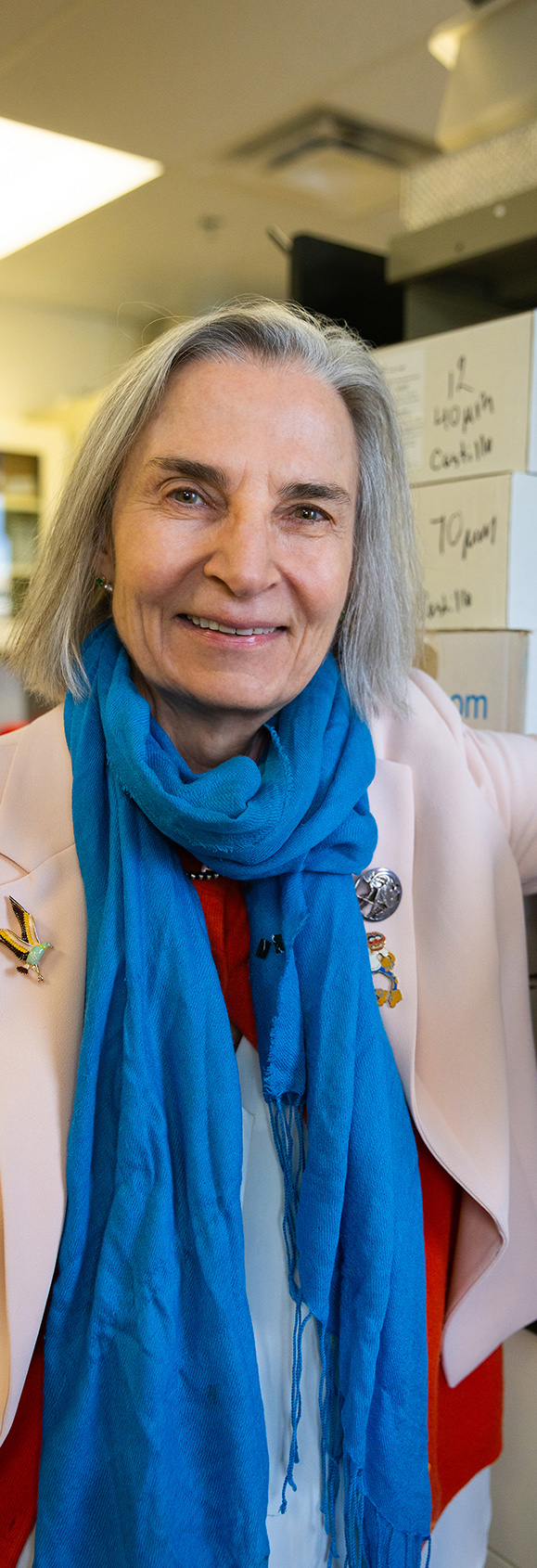
The next stop was Boston, where she did a pulmonology fellowship at Harvard-affiliated Massachusetts General Hospital.
She completed postdoctoral work at the Harvard School of Public Health before joining the faculty at Harvard’s Brigham and Women’s Hospital.
“That’s where I started in this field of science, really integrating what I could apply to lung disease,” she says. “I really learned fundamental immunology, then applied it to clinical problems.”
Before long, Finn started getting calls to look at leadership positions.
"While I hadn’t been considering leadership positions on my own, due to the support of my colleagues and others, I welcomed new opportunities.”
That eventually led to a move to the University of California, San Diego, as the Kenneth M. Moser professor of medicine and director of the Division of Pulmonary and Critical Care Medicine.
She also was offered other leadership opportunities, including serving as president of the American Thoracic Society. “That’s where I started having a voice in health equity,” she says. “It’s all related to how do we make a more inclusive environment, not only in the care of our patients, but also in our science and our day-to-day encounters.”
Along the way, Finn and Perkins raised their daughter Devin, who now works for the World Health Organization. Some years back, Finn attended yoga teacher training alongside her daughter and became hooked. “It was one of the hardest and most satisfying times, because you really have to leave your vulnerability at the door – especially because your daughter is so much better at it!” she says.
After moving to Chicago in 2012, “I really embraced what were important areas for me and one was really thinking about inclusion, writ large,” she says. “The numbers showed our internal medicine residency had just 6% who were under-represented in medicine.” She worked with others to improve recruitment, and by this year, that proportion had grown to 50%.
In her research, Finn has focused on the microbiome and immune-mediated pulmonary diseases, including asthma, sarcoidosis, transplantation and lung injury, often in collaboration with Perkins. But her upbringing also drives an abiding interest in keeping patient care at the forefront of scientific exploration.
“My elevator talk is always about the integration of scientific discovery with health equity,” she says. “Thinking about that integration, it’s keeping the patient at the center as we train the next generation.’”
As she embarks on the next chapter of her career, Finn confesses to falling in love with the New Mexico’s scenery and its people.
“Here, I can take my dog out and see the most incredible sunrises that really give me pause,” she says. “The breath that I breathe, which is based a bit on my yoga passion, is pretty extraordinary. It really does clear your mind and your heart.”
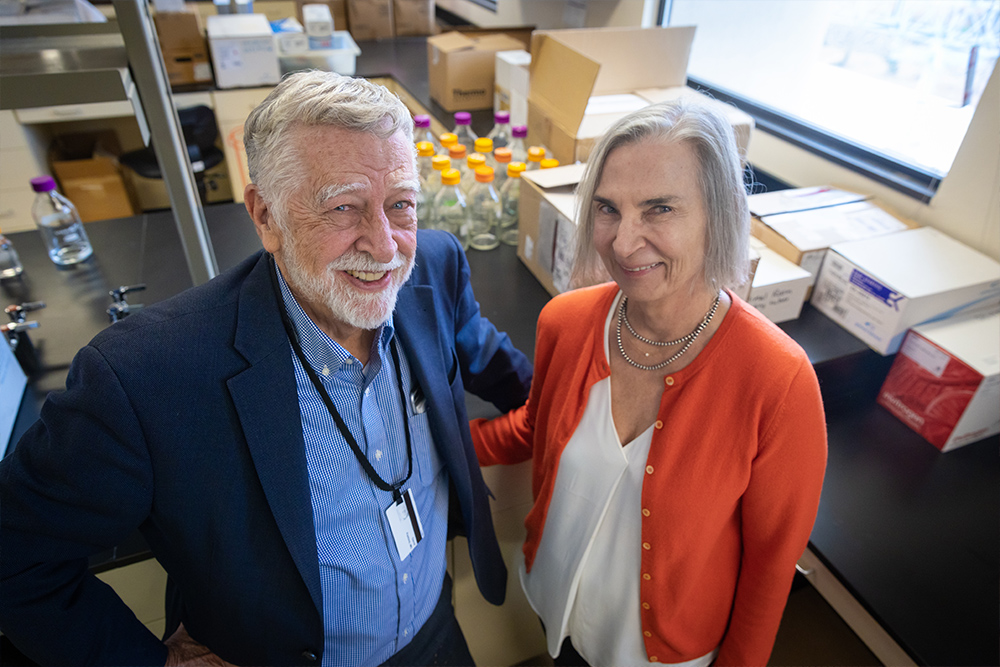
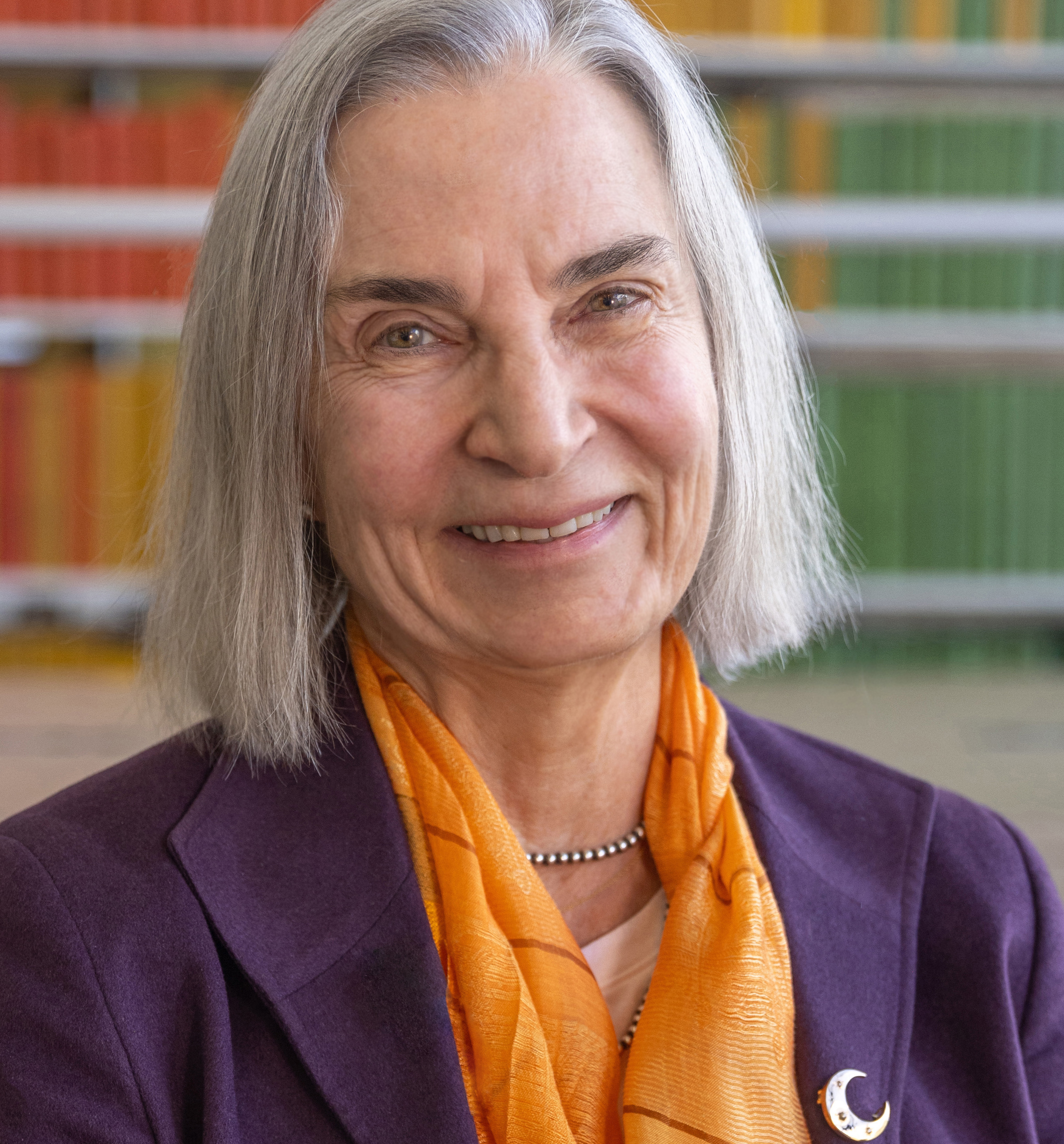
DEAN'S LETTER
Dear alumni, colleagues, donors and friends,
On Sept. 1, 2022, I was appointed as the fifth dean of the School of Medicine, an honor I proudly embrace.
Like many of our graduates, I am first generation (first to attend college, with immigrant parents), and I am passionate about training the next generation.
READ
MORE
CLOSE
DEAN'S LETTER
Dear alumni, colleagues, donors and friends,
On Sept. 1, 2022, I was appointed as the fifth dean of the School of Medicine, an honor I proudly embrace.
Like many of our graduates, I am first generation (first to attend college, with immigrant parents), and I am passionate about training the next generation.
My husband David and I are newly arrived to your state, and we already have experienced countless examples of unparalleled warmth and hospitality shown to us by New Mexicans.
Indeed, we understand how the Land of Enchantment rapidly transitions into the “Land of Entrapment,” where one never wants to leave.
I am looking forward to getting to know our alumni, and I want you to feel connected to what is going on in the School of Medicine.
That is why I am especially pleased to introduce the new issue of UNM Medicine. It explores so many of the features that make our School of Medicine unique.
In this issue, there are also some moving personal accounts.
Dr. Thomas Weiser, a School of Medicine alumnus who is a general and trauma surgeon at Stanford Medicine, has devoted much of his career to promoting safe and timely surgical career in low-resource regions around the world.
Our faculty have fascinating stories to share as well. The profile of Neurosciences department chair Bill Shuttleworth traces his journey from Adelaide, Australia, to New Mexico, where he has built one of the world’s pre-eminent programs in spreading brain depolarizations.
You will also learn about some of the impressive new construction happening around North Campus, including the Nene and Jamie Koch Comprehensive Movement Disorder Center, the Behavioral Health Crisis Triage Center and the Interdisciplinary Substance Use and Brain Injury facility.
I want to thank Dr. Michael Richards, Senior Vice President for Clinical Affairs at UNM Health Sciences, for his outstanding service as interim dean.
The School of Medicine is a rewarding place to work, and it plays such an essential role in educating the next generation of health care professionals for our state. We have some transformative initiatives in the works. Please stay tuned.
Best, ![]()
Patricia W. Finn, MD
Dean, UNM School of Medicine
AT A GLANCE: New Divisions & Programs
Elevated Expertise
New Surgical Division Delivers Advanced Liver, Pancreas and Biliary Care to New Mexicans
The Department of Surgery has created a new Division of Hepato-Pancreatico-Biliary (HPB) Surgery, dedicated to providing state-of-the-art care for liver, pancreas and bile duct-gall bladder diseases.
Surgical oncologist Itzhak Nir, MD, is the founding chief of the new division. He joined the UNM School of Medicine faculty in 2010 and practices at the UNM Comprehensive Cancer Center.
“As physicians, it is our mandate and responsibility to provide state-of-the-art care to our catchment area,” Nir said, noting that the UNM Cancer Center is the only one of its kind in a 500-mile radius.
In 2017, as Nir was performing a growing number of liver and pancreas surgeries, he proposed to the Department of Surgery and Cancer Center leadership that his practice be transformed into a service line. It soon became the regional center for the care of HPB ailments, with 1,500 new referrals over a two-year period.
These efforts received further academic recognition in June 2021 when the School of Medicine’s Committee of Chairs endorsed the creation of a 10th division within the Department of Surgery.
The HPB Division has implemented a perioperative improvement project that has played a key role in improving patient outcomes, Nir said.
“This endeavor encompasses the entire scope of surgical care, from the pre-operative clinic to the operating room and the in-patient floor, and finally looping back to the outpatient sphere,” he said. “It required cross-institution commitment, with collaboration of doctors across different departments and subspecialties, as well as the engagement of nurses and ancillary services.”
This five-year venture resulted in significant improvements, Nir said, including adherence to best practices, shortening the time to therapeutic interventions and length of hospital stay, lowering readmission rates, reduction of opioid use, improved global patient satisfaction, and resource utilization efficiencies.
Caring for Kids
New Division for Pediatric Hospitalists
Pediatric hospitalists at The University of New Mexico School of Medicine have a commitment to ensure all families receive high quality care when they are admitted to the hospital and have what they need when returning home.
Twelve pediatric hospitalists provide attending coverage to the General Pediatric Unit, Pediatric Subspecialty Unit and Carrie Tingley Hospital. This busy service has three teams and up to 50 patients at a time. As pediatric subspecialists, these hospitalists handle many complex cases.
Formerly, pediatric hospitalists at the UNM School of Medicine fell under the Division of Critical Care, which also included pediatric intensivists. But as the hospitalists section grew, it was clear it needed its own division.
“It’s been great being under the Division of Critical Care, but we thought it was time for us to branch off as our group was getting bigger and bigger,” said Melissa Sanchez, MD, UNM section chief of pediatric hospitalists.
Sanchez said the division will align with the American Board of Pediatrics and will be a valuable source of education, leadership and clinical service. She added that the division will also aid in recruitment and retention as well as support the department and hospital initiatives.
“In creating this division, UNM is recognizing that these kids that are coming in hospitalized will sometimes require a different skill set,” Sanchez said. “This is its own type of specialized medical care.”
Loretta Cordova de Ortega, MD, chair of the Department of Pediatrics, said the discipline of hospital medicine grew out of the increasing complexity of patients requiring hospital care and the need for dedicated clinicians to oversee their management.
The hospitalist model supplanted the traditional method of caring for hospitalized patients, which was often done by clinicians also seeing ambulatory patients or with other clinical obligations that limited their ability to provide the required intensity of care. By focusing their practice on this specific group of patients, hospitalists gain specialized knowledge in managing very ill patients and provide high-quality, evidence-based and efficient patient and family-centered care in hospital settings.
“It’s better for the patients because it’s a focused and specialized understanding of patient care,” Cordova de Ortega said. “Ten to 15 years ago, there weren’t very many hospitalist programs, but these days most large centers will have pediatric hospitalists who care for hospitalized children.”
“There was a lot of work involved in trying to establish what it would be like to create a division,” Cordova de Ortega said. “I’m so proud of Dr. Sanchez and the faculty in the division. They’ve really dedicated themselves to the mission of our institution and we’re proud to see what they’ve accomplished.”
INTENSIVE PARTNERS
Interdisciplinary Team in the UNM Center for Adult Critical Care Offers Patients Their Best Shot at Recovery
Physicians often speak of the “golden hour” as a window to provide lifesaving care for patients brought to an emergency department.
What comes next – a period sometimes described as the “silver day” – is equally important, as very sick patients are transferred to intensive care to be treated by physicians from The University of New Mexico Center for Adult Critical Care.
“If, in that first 24 hours, you don’t get resuscitated, your 30-day mortality is massively higher,” says Jon Marinaro, MD, co-chief, along with Michelle Harkins, MD, of the Center for Adult Critical Care at UNM Hospital.
Resuscitation, in this case, means managing multiple conditions and restoring full function to the patient’s organs while staving off renal, brain and lung failure, Marinaro says.
The Center for Adult Critical Care is a unique interdisciplinary resource, bringing together 55 critical care doctors from six departments in the UNM School of Medicine: Anesthesia & Critical Care Medicine; Surgery; Internal Medicine; Emergency Medicine; Neurosurgery and Neurology.
First established in 2015, the center’s organizational model enables physicians from different specialties who train and work together to address patients’ acute medical needs – and that translates into better outcomes, Marinaro says.
Steve McLaughlin, MD, chair of the Department of Emergency Medicine, says UNMH, with the only Level I trauma center in the state, has several unique features that contribute to a deep talent pool in critical care.
“The fact that we’re a trauma center, and the fact that we’re the referral center for all of the really complicated and sick patients in the state of New Mexico, creates a concentration here of both patients in our care, but also providers who are really committed to providing that high level of trauma care and high levels of other types of critical care,” he says.
“That’s really allowed us to focus on it at the institution, and I think the mission of the institution is one of the things that has attracted so many talented people. Our intensive care group here is really phenomenal. We’re recruiting people from some of the best programs in the country to come here to New Mexico to be part of this group.”
Adds Marinaro, “Critical care at The University of New Mexico has really come into its own.”
AT A GLANCE: Medical Mentoring
SARAH VILLARRIAL HAD TO LEAVE HER HOMETOWN OF FARMINGTON, N.M., TO APPRECIATE WHAT MADE IT SPECIAL.
READ
MORE
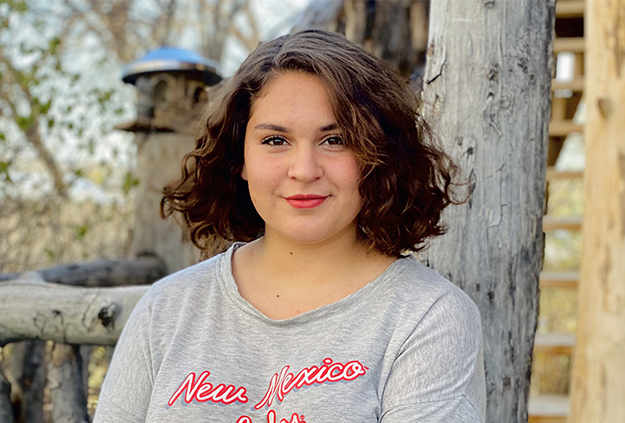
CLOSE
AT A GLANCE: Medical Mentoring
SARAH VILLARRIAL HAD TO LEAVE HER HOMETOWN OF FARMINGTON, N.M., TO APPRECIATE WHAT MADE IT SPECIAL.
The rising junior in the undergraduate phase of The University of New Mexico Combined BA/MD Degree Program spent the month of June in Farmington with four of her classmates as part of their Summer Practicum.
The students shadowed local physicians during patient visits, met with community members and studied health policy issues.
“It has been so nice to come back to the community,” Villarrial said. “You come back and you’re like, ‘Wow, this place is just amazing. You have such an appreciation for the community.”
The Summer Practicum is an annual feature of the Combined BA/MD Degree Program, a collaboration between the UNM College of Arts & Sciences and the UNM School of Medicine that was launched in 2006 to address the physician shortage in the state’s rural and underserved areas.
Each year, the program admits 28 students from high schools all over New Mexico and the Navajo Nation who are committed to becoming doctors and serving the state.
This year’s Summer Practicum was unique in that several of the physicians helping to teach the curriculum are themselves graduates of the BA/MD program, said program director Sushilla Knottenbelt, PhD.
“It feels very full circle,” she said. “The program is realizing its mission and our alumni are practicing in these rural areas and connecting with the students coming up through the pipeline.”
The program has 49 practicing alumni, Knottenbelt said, 34 of whom are based in nine communities across New Mexico. Alumni tend to choose primary care specialties more often than their peers in the School of Medicine, she added Current participants in the program come from 30 of New Mexico’s 33 counties, and two thirds of them are from outside the Albuquerque metro area, she said.
This year’s Summer Practicum also sent students to Las Cruces, Las Vegas, Roswell, Hobbs, Silver City and Taos, Knottenbelt said. BA/MD alumni Nikifor Konstantinov, MD, and David Hernandez, MD, served as “circuit riders,” traveling to each of the communities for three-hour weekly seminars in which the students integrated their experiences within the framework of the social determinants of health and the Program's Health Medicine and Human Values curriculum.
During her practicum Villarrial got to shadow fellow Farmington native William “Curtis” Young, MD, a family medicine physician who entered the BA/MD Program in 2008 and returned to the community in 2020 following a residency in South Dakota. Young’s father, physician assistant Bill Young, helped encourage Villarrial to apply to the Combined BA/MD Program while she was in high school.
Curtis Young says he had Villarrial in the room as a “fly on the wall” when he met with patients. “I introduced Sarah to them and told them she’s a Farmington girl that UNM is borrowing for a few years and then they’ll give her back,” he said.
Young’s wife, Shawna Young, MD, is a pediatrician who was a year behind him in the BA/MD Program. “My wife was the first in her family to graduate from college, and being Navajo, she is now taking care of a near-majority Navajo population in her practice,” he said. “In order to ‘hood’ someone at graduation, you have to be an MD, PhD or judge, or something. I had the amazing opportunity to place the hood on my wife at graduation.
“That’s something the BA/MD program made possible, and I’ll always be grateful for that. And now we practice together in a small New Mexico town trying to help other students believe in their dreams of helping people.”
Villarrial said shadowing Young on the job was one of the high points of her practicum experience.
“It’s been really cool,” she says. “Dr. Young is brilliant. He’s very intelligent. He’s in family medicine, so there is some down time if a patient cancels. He’ll sit me down and at a whiteboard and he’ll do a biochem lesson or he’ll teach me about a medical philosophy. He’ll ask his patients if it’s OK if I help with an exam."
“That hands-on learning is really amazing, because I think experience is the only way to learn medicine.”
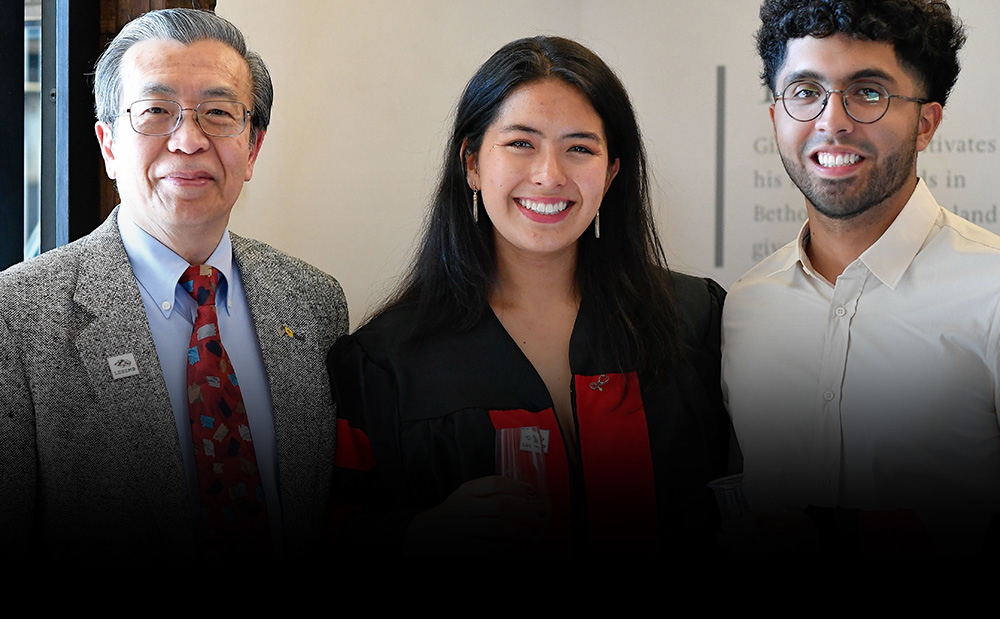
Lobo MD Scholarship
Thanks to your generosity, last year we were able to fund 41 graduates with the Lobo MD Scholarship, which provides direct support for Fourth Year medical students on their way to residency.
READ
MORE
CLOSE
Lobo MD Scholarship
Thanks to your generosity, last year we were able to fund 41 graduates with the Lobo MD Scholarship, which provides direct support for Fourth Year medical students on their way to residency.
Your $1,000 scholarship will match you directly with a student in the MD class of 2023.
Help us reach our goal of providing a scholarship to every graduate this year.
Your gift helps close the gap, empowers future Lobo MDs to be successful in school and inspires them to give back.
Please Click Here To Donate

BUILD WE MUST
School of Medicine Growth Spurs New Construction on Campus
The UNM School of Medicine is continually looking to expand its educational, clinical and research offerings to meet New Mexico’s health care needs, but it’s no secret that space on campus is at a premium – and that is driving a spate of new construction.
READ
MORE
CLOSE
BUILD WE MUST
By Michael Haederle and Makenzie McNeill
School of Medicine Growth Spurs New Construction on Campus
The UNM School of Medicine is continually looking to expand its educational, clinical and research offerings to meet New Mexico’s health care needs, but it’s no secret that space on campus is at a premium – and that is driving a spate of new construction.
These new facilities promise to improve patient care and medical education while supporting critical research addressing some of the state’s most pressing health problems and ensuring room to grow in the future.
CENTER OF EXCELLENCE FOR ORTHOPEDIC SURGERY & REHABILITATION
The first project to get underway, the UNM Center of Excellence for Orthopedic Surgery & Rehabilitation, opened last December on the UNM Health Sciences Rio Rancho Campus.
The two-story 50,000-square-foot structure, located adjacent to UNM Sandoval Regional Medical Center (SRMC) includes exam rooms for patients to consult with surgeons, an extensive orthopedics research laboratory and a rehabilitation facility.
“It’s such a great synergy with what’s happening already at SRMC,” says Jamie Silva-Steele, RN, MBA, SRMC’s president and CEO. She notes that the hospital already hosts a robust joint replacement practice. “What I envision over the five-year period is that we’ll add five more total joint surgeons, plus learners. It just helps us to maximize our surgical platform.”
The $21 million project was funded through Rio Rancho’s gross receipts tax revenues, with some of the money coming from cash on hand and $15 million from bonds raised against future tax receipts.
The new facility also provides ample space for research led by biomechanical engineer Christina Salas, PhD, MSc, associate professor in the Department of Orthopaedics & Rehabilitation and special assistant to the dean of the School of Engineering.
It also includes room for a cadaver lab and two Biosafety Level 2 workstations and accommodates visitors who can safely view the work being done through a glass wall, reflecting the facility’s educational mission, Salas said.
INTERDISIPLINARY SUBSTANCE USE & BRAIN INJURY CENTER
On Jan. 7, ground was broken for the Interdisciplinary Substance Use and Brain Injury Center (ISUBI), a game-changing facility that will enable advanced research into some of the state’s most persistent health care challenges.
The two-story 15,700-square-foot facility will be based in a new wing on the west side of Domenici Hall on UNM’s North Campus.
It will house basic research facilities to enable state-of-the-art closedloop recording and stimulation of brain activity in both human and animal subjects, advanced computational resources and simulated settings to test behavioral interventions.
The project’s $12 million price tag includes a fiveyear, $4 million construction grant from the National Institutes of Health, and $8 million in UNM Health Sciences funding. The construction is due to be completed by the end of 2022.
Bill Shuttleworth, PhD, chair of the Department of Neurosciences, will serve as the project’s scientific lead, while Michel Torbey, MD, chair of the Department of Neurology, and Andrew Carlson, MD, associate professor in the Department of Neurosurgery, will co-lead the brain injury program. Ludmila Bakhireva, MD, PhD, professor in the College of Pharmacy will lead the substance abuse initiative.
BEHAVIORAL HEALTH CRISIS TRIAGE CENTER
On Sept. 26, Gov. Michelle Lujan Grisham joined UNM Health Sciences and Bernalillo County leaders in breaking ground on a new Behavioral Health Crisis Triage Center that will enhance the ability to provide care to people experiencing mental health crises.
This new facility received $20 million from the Bernalillo County behavioral health tax initiative and a $20 million match from UNM Hospital.
It will comprise 48,699 square feet and sit adjacent to the UNM Psychiatric Center and is set to open in 2024.
The building will include the Crisis Triage Center, which will provide medium-acuity crisis stabilization services with 16 single patient bedrooms. Other spaces include group therapy and staff support areas, as well as a 23-hour observation unit.
The Peer-Based “Living Room” Model will offer low-acuity walk-in or referral services in a welcoming environment accessed by a separate public entrance and lobby. This program will also include a respite area, living room space, nourishment area and client work rooms.
UNMH Psychiatric Emergency Services will expand its existing program to the new facility to better serve patients who present with greater psychiatric acuity.
UNMH CEO Kate Becker says the new facility will help bridge an existing gap in the levels of care for behavioral health patients in the Albuquerque area.
“Right now, we have many people that do not meet inpatient admission criteria,” she says. “The Behavioral Health Crisis Center will help patients who are not acute enough to be in the hospital, but still need more support than just regular outpatient care.”

NENE & JAMIE KOCH COMPREHENSIVE MOVEMENT DISORDER CENTER
And on Nov. 1, Health Sciences leaders dedicated the Nene and Jamie Koch Comprehensive Movement Disorder Center – the only such center in the state. The 16,322-square-foot clinic was designed to house a full spectrum of specialists committed to movement disorder care, says Amanda Deligtisch, MD, a professor in the UNM Department of Neurology.
It will accommodate three physicians and a nurse practitioner, plus nurses, medical assistants, physical therapists, occupational therapists and speech therapists. “We have a whole pod set aside for research – for future research endeavors and clinical trials that we currently have,” Deligtisch says.
“It’s a much more comprehensive team-based approach when we’re all in the same place,” she said. “The goal is some more same day visits, so if we identify somebody having an acute rehab need – having a little more difficulty with their gait – we could get them over to the gym and have a physical therapist take a look at them then and there and work with them for 30 minutes and tune up their walking a bit.”
The Movement Disorders Center is connected to the Senior Health Center, which includes clinical space for the UNM Center for Memory & Aging. Jamie Koch, a former legislator and UNM Regent, rallied support from the New Mexico Legislature for the building’s construction following his own Parkinson’s diagnosis.
New Mexico has an aging population with a growing need for specialized movement disorder care. Some 5,300 of the 1 million Americans with Parkinson’s disease live in New Mexico.
An estimated additional 5,000 New Mexicans have another movement disorder diagnosis.
LIFE'S WORK: Neural Networker
By Paige R. Penland
Bill Shuttleworth Leads the Department of Neurosciences in Exploring New Frontiers
C. William “Bill” Shuttleworth, PhD, has spent his life on the frontier, literally and metaphorically.
Hailing from Adelaide, Australia, a “city at the end of the world,” he was first drawn to astrophysics – the “final frontier.” As an undergraduate, however, he discovered an even more complex boundary to push at the edge of human understanding: Neuroscience.
“I was interested in brain modulation and different behavioral states,”
Shuttleworth says. “Then I became fascinated by the way you could interrogate the brain with pharmacology – to figure out how the
brain worked. I was like, ‘Holy smoke!
The brain is the most complicated thing in the known universe!’ That sent me in a new direction.”
Shuttleworth’s journey to the frontiers of human cognition took him from graduate work in the enteric nervous system at Flinders University in Adelaide to a postdoc studying gut regulation in Reno, Nevada.
In the early 1990s, research into pacemaker cells in the gut at the University of Nevada, Reno, was an academic curiosity. It has since developed into a promising new medical frontier. “They are now world leaders and get a huge amount of the NIH budget,” he says.
“I came from two places that are undervalued, where I appreciated the value of not being at Harvard and the value of being at an out-of-the-way place, doing great work with brilliant people,” Shuttleworth says. “Those experiences formed who I am and what I want to do in New Mexico – what I think the department can do.”
Shuttleworth became department chair in 2019. If the brain is the most complicated thing in the universe, aligning the minds of UNM medical students, clinicians, researchers and community stakeholders may be its biggest challenge. By using innovative communication strategies, however, he’s been able to shape both the narrative and department.
Some success stories begin and end with a perfectly executed plan. Most, however, require the protagonist to think on their feet – and learn to trust their enteric nervous system.
Shuttleworth’s chosen postdoctoral research topic, the study of schizophrenia, was derailed by a lab chief’s inconvenient sabbatical, so he had to scramble for a last-minute position at the Flinders University. “I didn’t think it was going to be a great place to do my PhD,” he says. “But they ended up being outstanding scientists. They had moved to Adelaide because it was out of the way,” he says. “I got the best training I could have gotten. They were nominated for a Nobel 18 Prize the first year I was in the lab.”
His success earned him a spot at the University of California, San Francisco, but he didn’t take it.
“When I was driving to San Francisco, I bumped into University of Nevada professor and Physiology Department chair Kent Sanders at a conference in Reno,” Shuttleworth says.
Sanders invited him to become a research fellow. That night, overlooking Lake Tahoe, Shuttleworth made a gut decision to stay in Nevada. “It was a slightly out-of-theway place, with a really smart team, answering all the big questions.”
Although he had struck gold, Shuttleworth still wanted to work with one of the most famous names in the field. “Dr. John A. Connor was amazing. He was on the cover of Science magazine for his beautiful imaging of neurons – something I’d been trying to do in Reno,” Shuttleworth says.
“I even paid my own way to a conference in Florida so I could meet him and ask for a job. But he was so intimidating that I never actually talked to him.”
Then synchrony – or serendipity – struck. Connor transferred to UNM when his wife got a top job at Sandia National Laboratories.
Shuttleworth ended up in Albuquerque shortly thereafter, although he hadn’t planned to stay. “It took me a year or so before I really fell in love with New Mexico. Then, I saw a faculty job posted.”
Shuttleworth joined the brand-new Department of Neurosciences in 1998, under then-chair Dan Savage and alongside Connor.
“The primary focus was how single neurons regulate calcium and how that relates to injury,” he says. “It was a big switch. I had never recorded from a brain neuron until I came to New Mexico. I had never worked in a lab researching anything directly related to brain disease.”
Soon, however, he would become an expert in stroke and neurotrauma, and later champion the study of spreading depolarization – or brain tsunamis. Today UNM is a recognized research hub.
“We’re now hosting the website and will be processing big data from all over the world here in Albuquerque,” he says. “I love that.
It reminds me of the Australian pioneering spirit. Give me some space and get out of my way. Let me see what I can do.”
Upon becoming department chair, “My first goal was to not break anything, and make sure I could maintain Dan [Savage]’s legacy of a great, interactive, vibrant department,” Shuttleworth says.
“Our department has a balance. We go all the way from genes to behavior. We work with clinical departments and conduct systems level research, looking at how groups of neurons work together to cause big changes in the brain.”
In 2015, he landed a $11.6 million federal grant to study stroke and traumatic brain injury with the aim of making UNM a national center in the field. “We’ve leveraged that into a new building, the Interdisciplinary Substance Abuse and Brain Injury Center,” he says. “We’re also the only internationally funded center that’s working on brain tsunamis.”
Together with colleagues in the Department of Neurosurgery, Shuttleworth has also created the New Mexico Spreading Depolarization Consortium. “We were able to form the consortium because of the intellectual space here,” he says. “Nobody stopped us. We really believe that this will change medicine.”
While research still dominates, Shuttleworth loves to teach. “I’m not at a research institute, I’m at a school of medicine,” he says.
We’re paid to educate, and then we do research on the side. That’s how it works.”
He’s also proven adept at innovative communication techniques to reach students, scientists and stakeholders.
In addition to his own popular TEDx Talk on brain tsunamis, he helped stage TED-style “Dazzling Brain” talks at the Albuquerque Academy and, in 2016 he brought a team from the Alan Alda Center for Communicating Science to UNM. “The Alda Center points out that if you don’t communicate clearly what you discover, you might as well have never done the experiment,” Shuttleworth says. The Alda Center also organized improv skits that brought together UNM investigators studying cognitive disorders and community members suffering from them. The workshop culminated in a video where community members explained the importance of a
scientific abstract.
“Having their message understood and incorporated into the lived experience of someone with multiple sclerosis, or the family member of an Alzheimer’s patient, had a huge amount of value to the investigators,” Shuttleworth says. “And for the community members, it was empowering.
“We try to break down the barrier between the scientist and the audience, to get rid of the power differential. That’s how you find common ground.”
Three years into his dream job Shuttleworth is “the happiest I’ve ever been. I can’t wait to get into work because there’s so much still to do, and fun people to do it with.”
He has explored his chosen frontiers successfully – in part by trusting his gut.
“I tell people, if you are making a decision, don’t write a list of pros and cons. Ask yourself first thing in the morning what should you do. Follow that. Because there is so much processing in the subconscious. We know a lot more than we give ourselves credit for.”
This approach has helped Shuttleworth find more than just success on the frontiers of neuroscience, but also happiness.
“Having the freedom to explore that every day here at the School of Medicine?
I wouldn’t trade it for anything.”
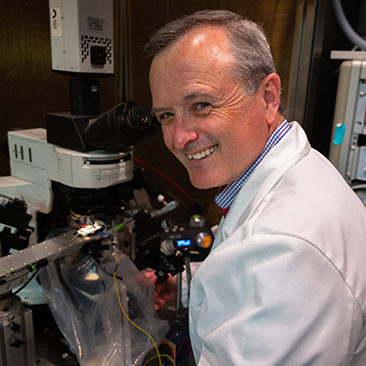

STUDENT AFFAIRS: Fundamental Foundation
Family, Values and Determination Shape a Medical Education
READ
MORE
CLOSE
STUDENT AFFAIRS: Fundamental Foundation
By Sageline LaBaze | Doctor of Medicine, Class of 2023
Family, Values and Determination Shape a Medical Education
Without a strong foundation, things are bound to fall.
LaBaze translates loosely to “the base” or “foundation” in French. When building a structure of architectural stability, the foundation ultimately determines the functionality, strength and longevity of the building.
In the same way, key features and values have shaped and supported my life. My namesake and life experiences have prepared me with a firm foundation on which my education rests and my career will be built.
My family is a fundamental element of my foundation. As teenagers, my parents emigrated from Haiti, one of the most impoverished countries on the planet.
They came to the U.S. to build a better life for themselves and their three children and went from having no understanding of English and working as janitorial staff to becoming registered nurses.
They taught my siblings and me through example to value education, help others, persevere despite all obstacles and always be there for each other.
These principles manifest themselves in our medical careers: my sister is an attending in family medicine, having graduated from the UNM Family Medicine residency program.
My brother is a UNM School of Medicine alumnus who went onto an orthopedic surgery residency program in Pittsburgh, and I am a current fourth-year medical student here at UNM going into preventive medicine.
My parents made countless sacrifices so that our family could grow from a solid foundation despite our disadvantaged backgrounds, and it is from these humble beginnings that I found my resilience.
Throughout my medical school career, I struggled with the loss of four classmates to self-harm and battled with health and financial obstacles that made paying for my education out of pocket a challenge, all while being a full-time caretaker to disabled family members.
If not for my foundational strength that my parents and last name established, I would have buckled under the weight of my adversities.
Despite these adversities, I never forsook my foundation of strength and am grateful to have transferred back home to UNM. It is through this unwavering resolve that I persevered despite all odds through the foundational support I have through my family and UNM.
My commitment to the underserved is reflected throughout my personal upbringing, as well as my collegiate and medical careers. In my undergraduate work, I took a "Race & (In)Equality in Healthcare" course, where I saw people with severely inhibited access to health care due to their social determinants.
I then volunteered for years through the New Mexico Department of Health at a free clinic called, “Casa de Salud” (House of Health) where patients throughout Albuquerque’s most impoverished areas would be able to seek care, no matter their background or circumstance. I also participated in the needle exchange program to prevent the dissemination of blood-borne diseases among local IV drug users.
I also contributed to the diversification of the student population by being a part of the admissions committee for my medical institution, as well as serving as the mentoring chair and currently as the co-president in my institution’s chapter of the Student National Medical Association. Most recently, I also participated in a health disparities elective at Johns Hopkins University where I learned more about mitigating health inequality/inequity throughout the country through my medical service.
My ultimate goal is to gain knowledge through study to be able to better serve the patients that seek my care. When knowledge is not enough, I will offer a warm heart to those around me.
The ideal setting of my medical career throughout the decade would be in one where I can provide services directly to underserved communities. I would want to have an outpatient clinic where I could tend to the uninsured, to the hard workers of the middle to lower class, to the homeless, and to all who come seeking health care.
I believe that everyone should be treated with the utmost respect and kindness, regardless of their backgrounds. I will be able to relate to patients due to my personal medical and socioeconomic history, and connect to them with genuine compassion, while maintaining professionalism.
It is my greatest hope to have these components be the foundation of my career as I feel that these are skills that many doctors lack, and as a result, I can help be the change I wish to see in the medical world.

ALUMNI PROFILE: Global Concerns
Thomas G. Weiser, MD ’02, MPH, Improves Access to Surgical Care Worldwide
READ
MORE
CLOSE
ALUMNI PROFILE: Global Concerns
By Elizabeth Gibson
Thomas G. Weiser, MD ’02, MPH, Improves Access to Surgical Care Worldwide
Even in the most sterile of operating rooms with resources aplenty, surgery can still be – and often is – a complicated procedure.
So, every time Thomas G. Weiser, MD ’02, MPH, a general and trauma surgeon, scrubs in, he must do his best to navigate all the complexities and intricacies of an acute surgical emergency.
When delivering acute surgical services in resource-poor settings, where requirements for safe and effective operating rooms are scarcely met, resource-related complications in the operating room can turn fatal.
That’s why the bulk of Weiser’s career and his research at Stanford University Medical Center has been focused on dismantling barriers to access and provision of surgical care and real-world implementation challenges in low-resource settings.
Despite the clear benefits of access to safe and timely surgical care, the poorest third of the world's population only receives 3.5% of approximately 234 million major surgical operations performed globally.
“Of the seven billion people alive today, it’s estimated that to be five billion people who cannot access safe affordable timely surgery when needed,” Weiser said.
“It’s not that five billion people need surgery – it’s just that five billion people live in places where there are either systemic problems accessing care – like geography, lack of providers, or lack of materials – or there’s a lack of financial security.”
These low operative volumes, compounded by the shortage of health care workers and surgical workforce in those low- and middle income regions, are associated with high case fatality rates from common treatable surgical conditions.
“We estimate that there are probably 143 million operations that are not performed that are necessary just for basic health needs,” he said. “And at least 1.5 million people die because of lack of surgery every year.”
Weiser said he first became interested in global health while attending The University of New Mexico School of Medicine. “I was interested in how systems of care work to provide the best possible care for patients,” he said.
“Most academic clinicians are busy enough with their clinical work or research, so the fact that Tom also takes an extensive amount of time with a nonprofit like Lifebox is incredible,” said Lifebox Global CEO Kris Torgeson. “Tom never stops and, on top of all his other clinical work, he is constantly engaged with Lifebox. He’s an incredibly smart, practical and very nice person on top of being an excellent researcher and mentor and supporter of global surgery.”
Weiser recently worked with a team in Ethiopia – where people giving birth are 23 times more likely to die than a person giving birth in the U.S. – to pilot Clean Cut, a Lifebox program that has been proven to reduce the relative risk of infection by 35% for all surgical patients.
The Clean Cut program launched in 2020 after Lifebox received a Bill & Melinda Gates Foundation Grand Challenge Initiative grant, in which Weiser was named as the program’s principal investigator. The $300,000 from the grant, funded by the UBS Optimus Foundation, supported implementing the program in 10 Ethiopian facilities.
“He launched that program and really pushed for it,” Torgeson said. “And now, because that program has had really great results, we’re starting to spread Clean Cut throughout Ethiopia, and also in Liberia, Madagascar, Bolivia and Malawi.”
Throughout the Clean Cut program, Weiser worked with Lifebox Global Clinical Director Tihitena “Tito” Negussie, a pediatric surgeon based in Ethiopia.
“Dr. Thomas Weiser is an amazing man full of new ideas to change the scientific world,” she said. “His work in the perioperative system impacted many of the professionals, as well as the patients globally. The target of his work is to address the system and the human power so that the change will be sustainable.”
Negussie said Lifebox gave her the chance to work with Weiser, and that she’s learned a lot from him.
“His skill in research, innovation and training supported the work Lifebox is envisioning as well as empowering the team at Lifebox so that these team members can be champions,” she said. “Tom is a dynamic, supportive game changer and team leader who envisions the surgical system to be in a better state soon.”
On a national level, Weiser also has interest in U.S. domestic policy as it relates to trauma outcomes, trauma systems, insurance coverage and costs of care, and firearm violence.
Weiser was still a medical student at UNM when he treated his first gunshot victim – a teenage boy.
“Some of the kids I took care of in the early part of my career are probably some of the most memorable,” he said. “There are certain cases that are particularly poignant – and inevitably the kids are the most poignant.”
Since then, he’s treated so many victims of gun violence that “it’s kind of become a blur,” he said. “Unfortunately, gun violence is so frequent, and we see it way too often.”
He’s published papers on how dismissing firearm legislation is ineffective in preventing incidence of mass shooting events as recently as September 2022.
“From a medical perspective, we’ve done a grave disserve to our population by not understanding that the problem of gun violence is a public health issue. We need to do a much better job, but we don’t have the data,” he said. “And it’s become so politicized that it’s hard to discuss without people getting wrapped up in the politics of gun rights versus gun control.”
Instead, Weiser tends to discuss gun violence from an economic perspective. In 2017, he co-wrote a paper where he analyzed inpatient hospital records to conclude that the initial hospitalization of patients wounded by guns over an eight-year period cost Americans more than $6.6 billion. Weiser said this is because most victims of gun violence tend to be under-insured or not insured at all.
“I’m not even talking about emotional cost – I’m talking about dollars and cents,” he said. “Be it at the hospital or in recovery, etc., the cost turns out to be really, really high.”
Looking forward, Weiser hopes to continue saving lives through safer surgery.
One of Weiser’s newest projects involves Wellcome Leap, a nonprofit that funds global human health programs.
“I’ll be taking over a big program in surgery in October,” he said. “It’s really focused on the global context, but all surgery is local, so the program will have applications in the U.S. and abroad.”
Currently, Weiser splits his time between Stanford, where he continues to do clinical work, and the U.K., where his family lives. Weiser said he went to the U.K. on sabbatical five years ago, but that his family enjoyed England so much that they wished to stay.
He has since worked as a visiting professor at the University of Edinburgh.
“I have a very unusual work-life balance,” he said, laughing. “It’s very unusual for a clinician to have this kind of work, but it seems to work, and my family is happy.
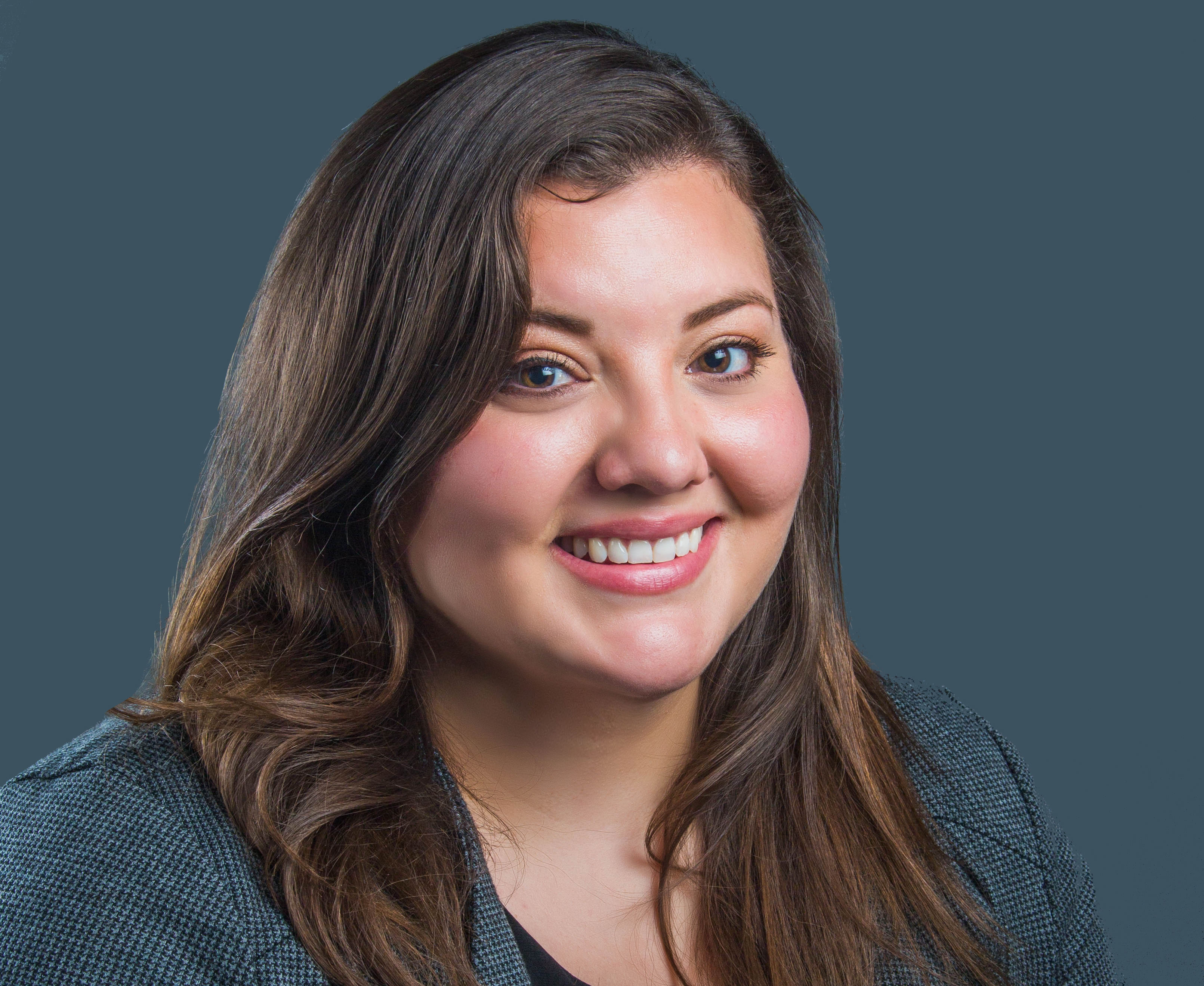
DIRECTOR'S LETTER: Advancement & Alumni Relations
Dear Friends,
The 2022-2024 Strategic plan for the Office of Advancement and Alumni Relations begins with a renewed focus on the generosity and participation within our community. What an exciting and meaningful year of generosity and participation we have had.
READ
MORE
CLOSE
DIRECTOR'S LETTER: Advancement & Alumni Relations
Dear Friends,
The 2022-2024 Strategic plan for the Office of Advancement and Alumni Relations begins with a renewed focus on the generosity and participation within our community. What an exciting and meaningful year of generosity and participation we have had.
2022 GENEROSITY
Thanks to our generous donors, the Alumni Association and La Tierra Sagrada Society (LTSS) received more than $128,000 in annual fund gifts and endowment distributions so far this calendar year as well as an additional $13,427 in gifts to existing endowments.
Thank you for supporting students and new alumni through your generosity.
2022 funding enabled the School of Medicine to make an impact in current students’ lives. In total, LTSS and the Alumni Association were able to award a total of 110 scholarships totaling $213,000 directly to MD, OT, PT and PA students.
The Alumni Association's successful Lobo MD Scholarship inaugural campaign – awarding $41,000 – is of particular note. Lobo MD's second campaign is open for donations through Feb. 2023.
Please support the Class of 2023 with a donation.
2022 PARTICIPATION
This year our alumni engaged with students, faculty and staff through local events and activities which included serving as mentors and speakers at events including Match Day, Convocation, Transitions and White Coat ceremonies.
Campus & Student Affairs Events: Alumni gathered at receptions across the nation, including Denver, Boston and San Diego, and across our beautiful state - Santa Fe, Farmington, Silver City and Las Cruces.
Lobo MD Reunion 2022: I would be remiss if I did not mention the incredible participation at the Lobo MD Reunion. Our Dias de Los Lobos theme was a huge hit, and the opportunities for celebration and pride were over the top. Congratulations to the Department of Family & Community Medicine (FCM) for celebrating their 50th anniversary as part of the reunion activities, as well as celebrating three FCM alumni who received awards in each of the categories, including the first Living Legend Award made since 2018.
A Living Legend Award was bestowed with great admiration on Dr. Warren Heffron, longtime UNM faculty member and former chair of FCM. You can watch Dr. Heffron’s inspirational tribute video on School of Medicine social media or our website. Re-live each of the reunion events by viewing photos from the event on the School of Medicine’s website.
Reunion also marked the end of the term of Nate Roybal, MD ’07, Alumni Association president. Join me in thanking Dr. Roybal for his service and leadership and in welcoming Alisha Parada, MD '08, as president. We are so fortunate to have leaders like these on our Alumni Board.
Keep in contact with our team this coming year to increase your giving and participation at the UNM School of Medicine.
Sincerely,
Ashley M. Salazar, MA
Chief Advancement & External Relations Officer
UNM School of Medicine
BOARD REPORT
UNM SCHOOL OF MEDICINE ALUMNI ASSOCIATION
BOARD OF DIRECTORS
Alisha Parada, MD ’08 (President)
Nate Roybal, MD, PhD ’07 (Immediate Past President)
Albert Kwan, MD ’83
Linda Stogner, MD ’83
Valerie L Romero-Leggott, MD ’92
Dion Gallant ’99
Robert Melendez, MD ’00 (Past President)
Jennifer K Phillips, MD ’01 (Past President)
Angela Gallegos-Macias, MD ’02
Mario Leyba, MD ’04
Randolph Baca, MD ’07
Athanasios Manole, MD ’14
Jaren Trost, MD ’15
Daphne Olson, MD ’17
STUDENT & RESIDENT REPRESENTATIVES
Jessica Benally, MD ’23
Arash Kheyraddini Mousavi, MD ’24
Danielle Ortiz , MD ’25
Rosstin Ahmadian, MD/PhD ’25
Jeffery Booker, MD ’26
EX-OFFICIO MEMBER
Patricia W. Finn, MD
Dean, UNM School of Medicine
ADVANCEMENT AND ALUMNI RELATIONS
CHIEF ADVANCEMENT & EXTERNAL RELATIONS OFFICER
Ashley Salazar
ASSISTANT DIRECTOR, ALUMNI RELATIONS
Erika Anderson
OPERATIONS SPECIALIST
Ashley Hatcher
EVENT PLANNER
Ruth Morgan
ADVANCEMENT & EXTERNAL RELATIONS ASSISTANT
Destiny Onnen
CONTACT
UNM School of Medicine
Office of Advancement and Alumni Relations
MSC 08 4720 • Fitz Hall #182B
1 University of New Mexico
Albuquerque, NM 87131-0001
505.272.5112
GIVING PROFILE: A Life Well Spent
Bill Rothanbarger’s Financial Success Translates Into Scholarship Support
READ
MORE
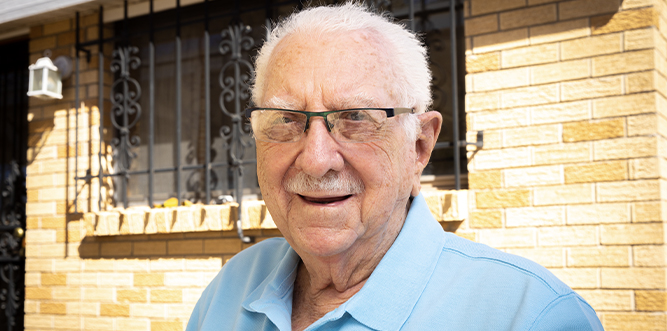
CLOSE
GIVING PROFILE: A Life Well Spent
by Emily Monteiro Morelli
Bill Rothanbarger’s Financial Success Translates Into Scholarship Support
Like so many of his generation, Bill Rothanbarger learned early lifelong lessons about the value of money, education and community.
With good humor, he recalls that as a child in Missouri during the Great Depression, he realized the value of industriousness with his first job.
As a six-year-old, he sold The Saturday Evening Post door-to-door for a nickel. For each magazine he sold, he kept a penny.
“That was 20 percent! The other kids were all so impressed,” he says, laughing. “A penny could get you two whole pieces of candy. But, when I experienced having some coins in my pocket, I decided that I really liked the sound of the jingle.”
It would be hard for that child to envision, in his late eighties, that the enjoyment of the jingle of making and saving money has translated to a very sizeable gift to The University of New Mexico School of Medicine.
“I don’t even know how I did it, honestly. They tell me that it will generate enough to pay for four students for all four years of their medical education,”
“I don’t even know how I did it, honestly. They tell me that [the gift] will generate enough [interest] to pay for four students for all four years of their medical education,” he explains, playing down a life lived frugally and his keen sense for investing.
Rothanbarger’s route from penny sales to donating his well-earned estate to the School of Medicine was not without its challenges and triumphs, marked by a family tragedy, military and public service, education, work and a substantial generosity of spirit clear to all with whom he interacts.
In high school, he worked in a Joplin, Mo., drugstore for 35 cents an hour, six days a week. “I saved enough money to go to the University of Kansas City School of Pharmacy,” he says. “While I was home over Christmas break my first year, my father passed away.”
He finished up that year and headed back home to help his family. “A death in the family can really change the course of everything for a person and a family, when income is lost,” he says.
Rothanbarger made the best of things when he was drafted into the U.S. Army during the Korean War. “I got a steady paycheck, I had a nice place to live, and I had all my meals cooked for me,” he says.
When he left the military, he went back to school and graduated from Pittsburg State College in Pittsburg, Kan., with a bachelor’s degree. After spending some time in a VA hospital in Arkansas for treatment of a lung ailment, he took a drive to visit his aunt and uncle in Albuquerque. They told him that the local public schools were hiring substitute teachers, and his career as a math teacher in the Albuquerque Public Schools began.
“I had $65 in my pocket when I got here and I paid $8 a week for a sleeping room downtown,” he says.
While Rothanbarger's quirky memory for the exact costs of living and the wages he made (no more than $27,000 per year at APS, with his retirement over 30 years ago) is impressive, it underlies his astonishment at his own financial accomplishments and the parallel story of his extensive, less financially rewarded exertions.
For instance, when Rothanbarger retired, he frequented a local donut shop. When the owner asked him to pitch in on a difficult day, Rothanbarger ended up volunteering for two hours a day for 15 years.
He was bestowed a Martin Luther King Jr. Award by a local organization for his work on civil rights and was elected to and served on the Albuquerque Public School Board for several years after his retirement. He also enjoyed serving on the UNM Hospital Board of Trustees and helped raise funds for KNME and for the Albuquerque Youth Symphony.
At 89, he makes lunch for and entertains daily a less fortunate friend. “I get so much back from him,” he says.
His proudest accomplishment, however, is the Licensed Public Nurse Program in the Albuquerque Public Schools, which ignited his passion for helping New Mexico’s students attain health care careers.
“These high school seniors graduate and immediately take a licensing exam,” he says. “This means that they can graduate with the promise of good-paying jobs, so that if they can’t afford to go to college, they still have a good living wage.”
When he decided to leave his estate to a worthy cause, his lawyer put him touch with the UNM School of Medicine and then Executive Vice Dean Martha Cole McGrew, MD.
“I loved talking to her and I thought it was a good idea,” he says. “My preference is that the scholarships first go to students who went through APS, then open up to students from around the state.”
Rothanbarger's deep pride in and value for the ability to make a living and build a bedrock of financial and career security for himself and others in his community is evident.
His commitment to these abiding principles is punctuated by two glorious beacons: the single showy, shining indulgence he allows himself – a top-of-the-line red Cadillac – and his everlasting gift to future students at the UNM School of Medicine, which is a gift to all New Mexicans and to the future of health care in our state.
GIVING: by the Numbers

in scholarships awarded

total gifts & pledges

unique donors

total # of gifts

in endowment gifts

current total endowments

new bequests
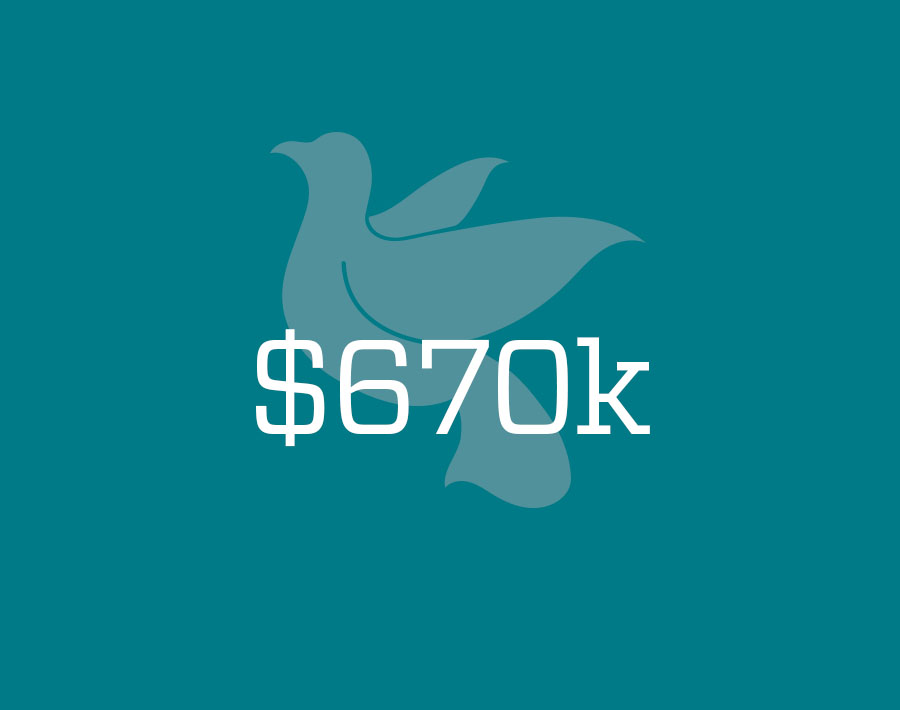
est. total value of bequests

in gifts to the dean's fund
2022 LIVING LEGEND: Warren Heffron, MD
Warren Heffron, MD, was one of the UNM School of Medicine Department of Family & Community Medicine’s founding faculty members. He also founded the School of Medicine’s Family Medicine Residency and served as residency program director for 13 years.
During his career of 53 years at UNM, Heffron served as acting chair, interim chair and chair of the department on three different occasions. He was a prolific practicing physician, teacher, administrator and researcher whose contributions continue to benefit the School of Medicine and the people of New Mexico.
READ
MORE
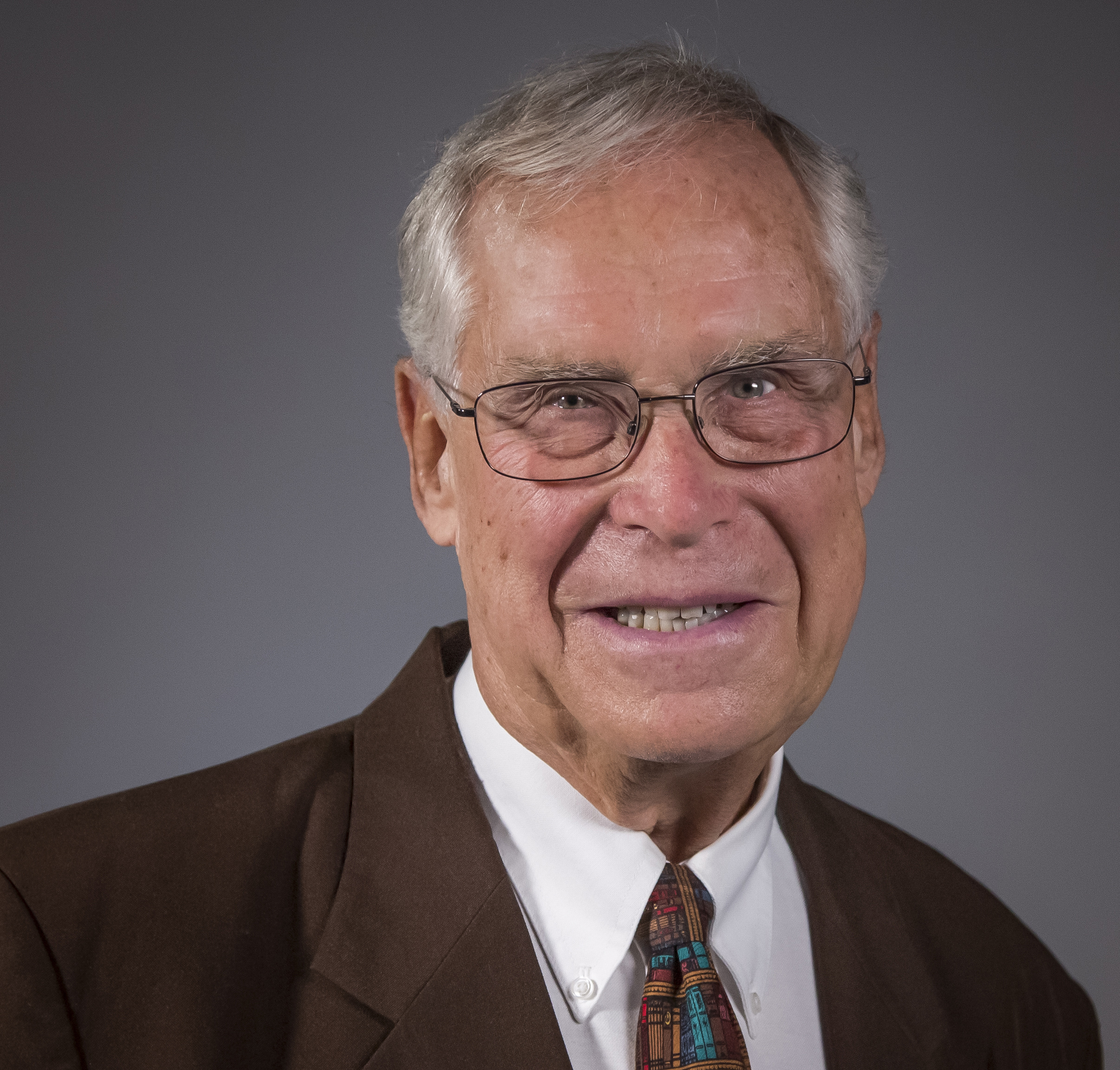
CLOSE
2022 LIVING LEGEND: Warren Heffron, MD
Warren Heffron, MD, was one of the UNM School of Medicine Department of Family & Community Medicine’s founding faculty members. He also founded the School of Medicine’s Family Medicine Residency and served as residency program director for 13 years.
During his career of 53 years at UNM, Heffron served as acting chair, interim chair and chair of the department on three different occasions. He was a prolific practicing physician, teacher, administrator and researcher whose contributions continue to benefit the School of Medicine and the people of New Mexico.
Heffron has been involved locally, nationally and internationally in multiple roles devoted to furthering the development of family medicine as a medical specialty. He served as president of the American Board of Family Medicine, vice president of the American Academy of Family Physicians, president of the Christian Medical and Dental Associations in the USA, president of the New Mexico Medical Society, residency consultant for the Residency Assistance Program of the AAFP, regional vice president for the Americas of the World Organization of Family Doctors (WONCA), and served on the Residency Review Committee for Family Medicine.
He has received multiple grants and awards. A few include outstanding faculty member at UNM, In His Image Residency in Tulsa, Okla., and as a visiting faculty member and visiting professor at the Christian Medical College in Ludhiana, India. He received an honorary professorship at the Kazakh National School of Medicine, and the Educator of the Year Award from the Christian Medical and Dental Associations.
He has been active in international residency and department consultations and has consulted for 64 programs in 23 different countries.
The Living Legend Award recognizes exemplary leaders who have dedicated their lives to humanity and devoted their careers to the mission of the UNM School of Medicine. Known for their extraordinary contributions to the UNM School of Medicine, Living Legends are our greatest touchstones of excellence. This honor recognizes their tireless efforts in educating the next generation of healthcare professionals, providing state-of-the-art and compassionate care to everyone regardless of the ability to pay, and conducting innovative research to find cures and treatments to improve the quality of life for future generations.
2022 ALUMNI ASSOCIATION AWARD RECIPIENTS
Distinguished Alumni Awards
Timothy Hurley, MD, FACOG '86 & Jennifer Phillips, MD '01
Leonard M. Napolitano, PhD Award
Dion Gallant, MD '99
Visionary Site of the Year Award
Department of Family & Community Medicine, UNM School of Medicine
READ
MORE

CLOSE
2022 ALUMNI ASSOCIATION AWARD RECIPIENTS
Distinguished Alumni Awards
Timothy Hurley, MD, FACOG '86 & Jennifer Phillips, MD '01
Leonard M. Napolitano, PhD Award
Dion Gallant, MD '99
Visionary Site of the Year Award
Department of Family & Community Medicine, UNM School of Medicine
2022 DISTINGUISHED ALUMNI
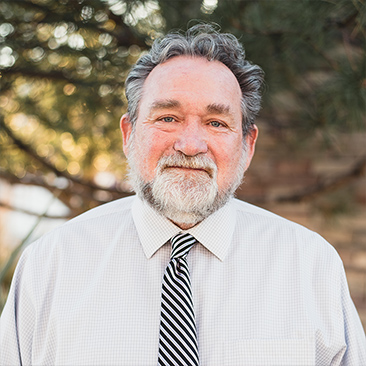 Timothy Hurley, MD, FACOG
Timothy Hurley, MD, FACOG
Class of 1986
Dr. Timothy Hurley has doctoring in his blood. His father was an orthopedic surgeon in Albuquerque for more than 45 years. Hurley, a board-certified OB/GYN for 20 years, taught maternal fetal medicine as an assistant professor at The University of New Mexico School of Medicine.
A student described him as an obstetrician, geneticist, radiologist, internist and patient advocate all rolled into one.
 Jennifer Phillips, MD
Jennifer Phillips, MD
Class of 2001
Jennifer Phillips, MD, joined the UNM Medical Group (UNMMG) as the Interim Chief Medical Officer in March 2020. She is a key physician leader in primary care, and an integral part of the UNMMG Clinical Operations Group. She has played a critical role in studying, developing, advocating for, and piloting the team-based model of care and is a lifelong New Mexican who graduated from UNM in 1997 and UNM School of Medicine in 2001. She practices patient-centered care and seeks to inspire her patients to be attentive to living healthy lives, involving the body, mind and spirit.
The true measure of the UNM School of Medicine’s greatness is found in the achievements of its alumni. The Distinguished Alumnus Award recognizes an alumnus who has made significant contributions to society, and whose accomplishments, affiliations and career exemplifies the School of Medicine’s legacy of excellence.
2022 LEONARD M. NAPOLITANO, PhD AWARD
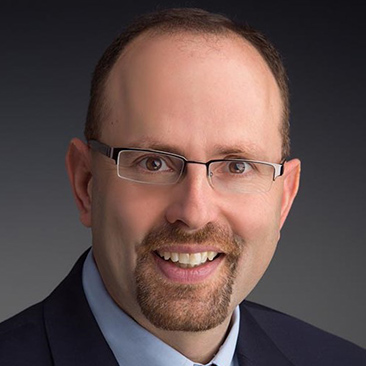
Dion Gallant, MD
Class of 1999
Dion Gallant, MD, is a family medicine physician who specializes in providing comprehensive, patient-centered medical care, health maintenance, and preventive service to patients of all ages. He also serves as the primary care medical director at Presbyterian Healthcare Services. Gallant received his bachelor’s degree in Western History from Georgetown University in Washington, D.C.. He is a member of the American Association of Family Practitioners and the American Medical Association.
Leonard Napolitano was the School of Medicine’s third dean, whose many contributions included development of the nationally recognized Primary Care Curriculum. The award recognizes an alumnus who has built strong public and private partnerships while advocating for the School of Medicine through innovation and commitment to education.
VISIONARY SITE OF THE YEAR AWARD
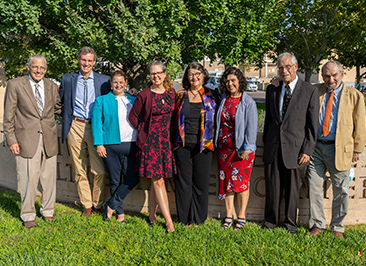
Department of Family & Community Medicine
UNM School of Medicine
Visionary Site of the Year awards recognize New Mexico health systems that embody the mission of the UNM School of Medicine in their dedication to education, creating a diverse network of health care professionals and providing compassionate care to all New Mexicans.
2022 ALUMNI REUNION SNAPSHOTS
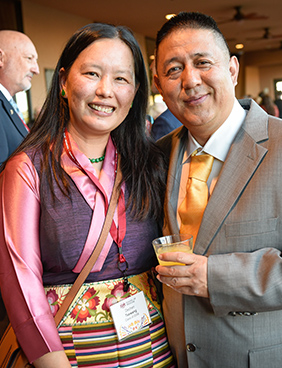
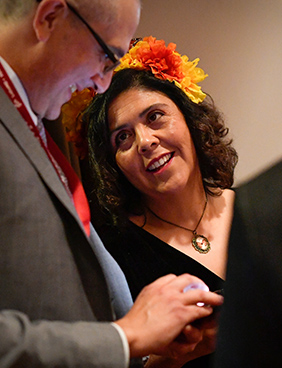
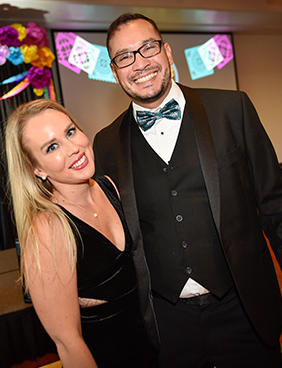
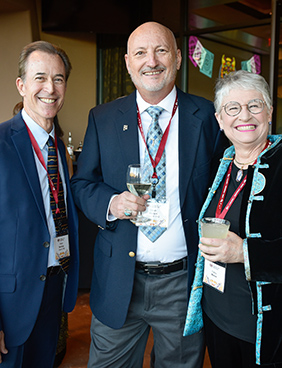
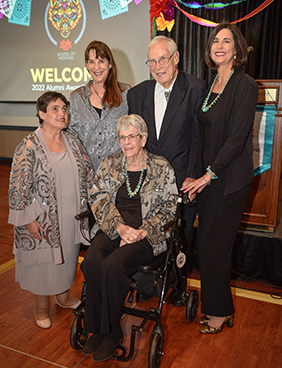
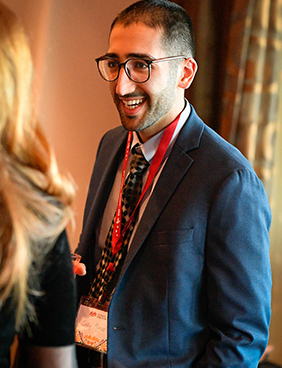

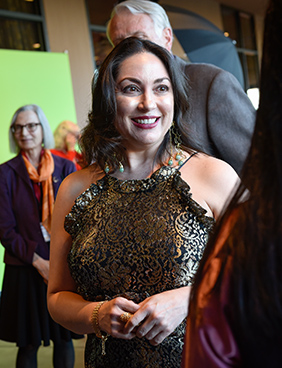
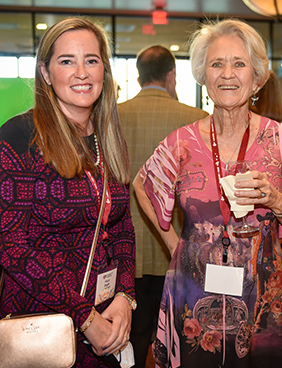
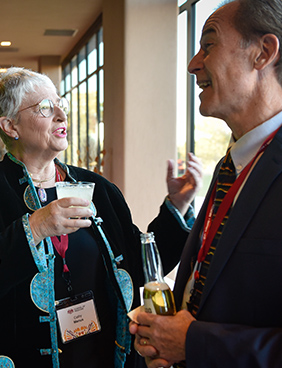

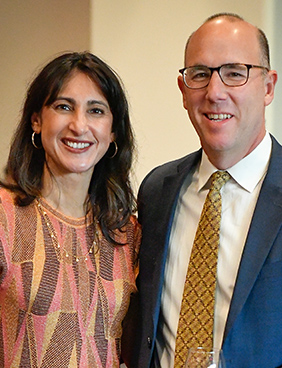
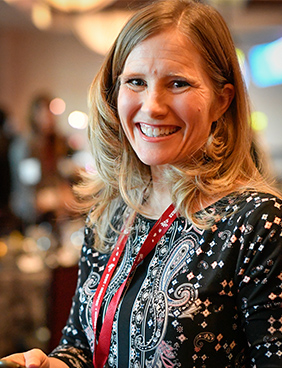

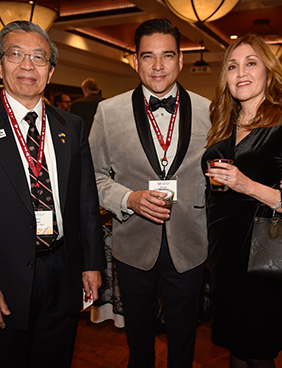

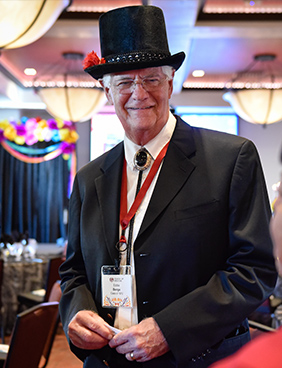
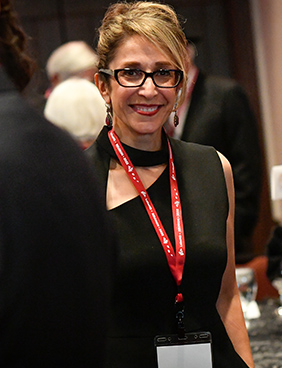
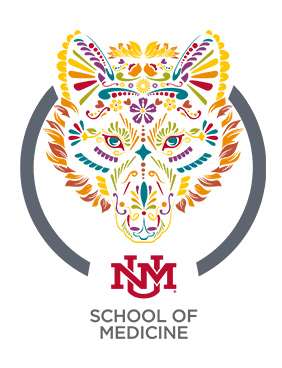
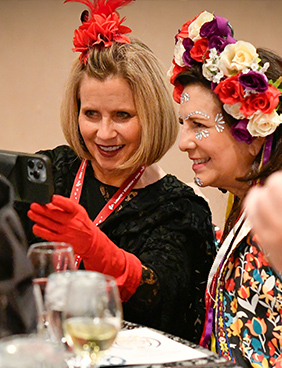
LA TIERRA SAGRADA SOCIETY: Scholarship Celebration Snapshots
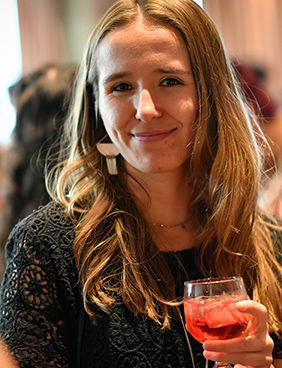
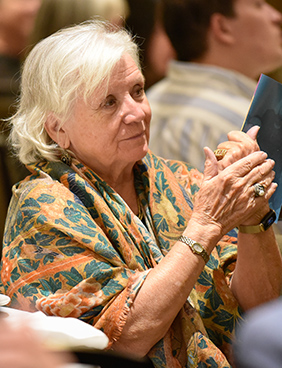
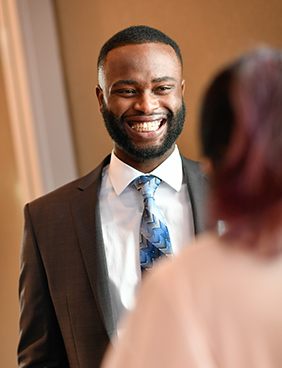
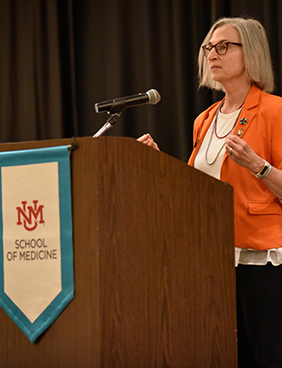
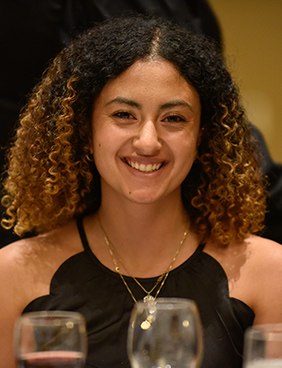
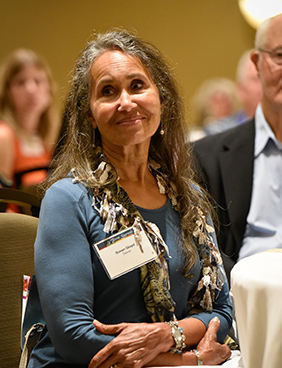
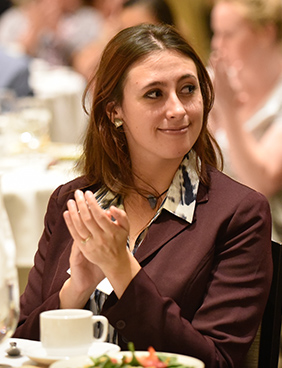
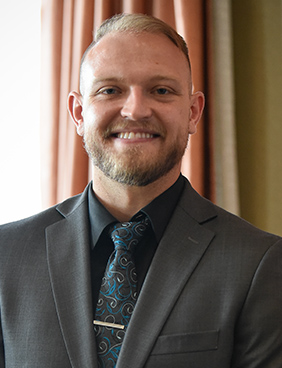
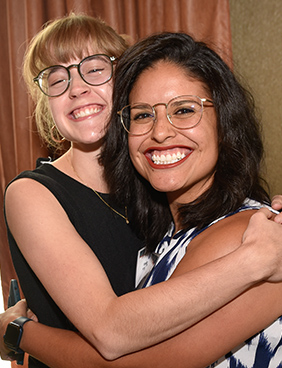
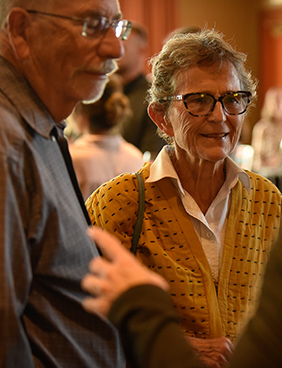

All of our alumni are class acts.
Help us brag a little! Please send us your good news, personal or professional, to share in UNM Medicine.
Email us at unmsomalumni@salud.unm.edu or give us a call at 505.272.5112
UNM School of Medicine
Office of Advancement & Alumni Relations
READ
MORE
CLOSE
CLASS ACTS
Help us brag a little! Please send us your good news, personal or professional, to share in UNM Medicine.
Email us at unmsomalumni@salud.unm.edu or give us a call at 505.272.5112
UNM School of Medicine
Office of Advancement & Alumni Relations
Alumni
Alfredo Ramon Vigil, MD ’77
Dr. Vigil is celebrating his retirement after serving the people of Taos, over a 40-year career. Congratulations, Dr. Vigil! Thank you for serving the mission of The UNM School of Medicine by advancing the health of all New Mexicans.
Michael F. Hartshorne, MD ’78
UNM Medicine alumni are sought after as content experts in many areas. Live Science interviewed Dr. Hartshorne to help explain why and how dark shadows were left behind after an atomic bomb was detonated at Hiroshima in 1945 (www.livescience.com/nuclear-bomb-wwii-shadows.html).
Melvina McCabe, MD ’84
Dr. McCabe contributed to the creation of “Vaccination from the Misinformation Virus,” a documentary that aims to help parents and community leaders understand the importance and safety of vaccines. The film premiered in Phoenix in July and to be streamed via the School of Medicine’s YouTube channel as part of the Community Lecture Series on December 2.
Robert E. Sapién, MD ’86
The Spears School of Business at Oklahoma State University welcomed its newest class, Cohort X, to the PhD in Business for Executives program. A familiar face in Cohort X is that of School of Medicine alumnus, Dr. Robert Sapién.
Charles Pace, MD, PhD ’96
Dr. Pace was named one of the “5 Best Pain Management Doctors in Albuquerque” by Kev’s Best, an independent blog that reviews and lists their views on the best businesses and major consumer markets across the country.
Laura Parajon, MD ’95
Dr. Parajon was awarded the American Academy of Family Physicians Public Health Award in recognition of her important contributions as a family physician to advancing the health of the public at the national, state and local level. She is deputy cabinet secretary in the New Mexico Department of Health and an assistant professor in the UNM Department of Family & Community Medicine.
C. Dana Clark, MD ’03
Dr. Clark was named one of “10 Total Joint ASC Physicians to Know” by Becker’s ASC Review, a business and clinical news site run by Becker’s Healthcare. He is one of only 10 doctors mentioned from across the country.
Lana Dolores Melendres-Groves, MD ’04
Dr. Melendres-Groves served as a featured expert speaker for the National Broadcast Series through United Therapeutics and the Pulmonary Arterial Hypertension (PAH) initiative. These virtual events educated people with PAH and their caregivers, providing insights and perspectives about how to manage life with their condition.
House Staff Alumni
Matthew David Katz, MD
Dr. Katz has joined CARTI, a statewide cancer care provider in Arkansas. Congratulations on your new position, Dr. Katz.
Jeremy T. Phelps, MD
An accredited neurosurgeon with INTEGRIS Spine and Neurological, Dr. Phelps was named one of Oklahoma’s five best neurosurgeons by Kev’s Best, an independent blog that reviews and lists their views on the best businesses and major consumer markets across the country.
Catherine Tchanque-Fossuo, MD
Western Dermatology Consultants welcomed Dr. Tchanque-Fossuo as a new provider as of July 2021. Congratulations on your new position, Dr. Tchanque-Fossuo.
Thomas Bernasek, MD
Dr. Bernasek was included as one of “10 Total Joint ASC Physicians to Know” by Becker’s ASC Review, a business and clinical news site run by Becker’s Healthcare.
Robert Zuniga, MD
Dr. Zuniga was named one of Albuquerque’s “5 Best Pain Management Doctors” by Kev’s Best, an independent blog that reviews and lists their views on the best businesses and major consumer markets across the country.
Faculty
Mary Ann Osley, PhD & Douglas Ziedonis, MD, MPH
UNM recently announced the promotion and honor of 10 faculty members, including Drs. Osley and Ziedonis, to the rank of Distinguished Professor, the highest title that UNM bestows upon its faculty.
Gurdeep Singh, DO
Dr. Singh was promoted to executive diversity and well-being officer at the UNM Sandoval Regional Medical Center in Rio Rancho. Dr. Singh is also an assistant professor in the Department of Internal Medicine. The new role includes leading a comprehensive diversity, equity, inclusion and well-being strategy for SRMC, working with hospital leadership to implement proactive diversity, equity, inclusion and well-being initiatives. Congratulations, Dr. Singh.
David S. Schade, MD & R. Philip Eaton, MD
Drs. Schade and Eaton successfully partnered to spearhead efforts in the New Mexico Legislature to require insurance coverage for coronary artery calcium screening, a proven method for detecting cardiovascular disease, and the pair continues to push to expand coronary artery insurance coverage.
Gulshan Parasher, MD
In 2020, the UNM Board of Regents and the School of Medicine honored Dr. Robert Strickland by approving the creation of an endowed distinguished chair in Strickland’s name to advance digestive health and science. In October, the School of Medicine announced the naming of Dr. Parasher as the inaugural Strickland Distinguished Chair.
Ann Gateley, MD
Dr. Gateley received the 2021 Outstanding Alumna Award at Sweet Briar College. The award was created to honor alumnae for their outstanding service to Sweet Briar in a volunteer capacity. After college, Gateley attended medical school at UNM and went on to be a sports medicine specialist, team doctor for UNM Athletics Department and Internal Medicine program director.
Gerald D. Otis, PhD
Dr. Otis hosted a book signing in Las Cruces, N.M., in July. Dr. Otis has written four books: Joseph Lee Heywood: His Life and Tragic Death (2011), Paroxysm: Love, Murder and Justice in Post-Civil War Washington, D.C. (2013), Presumed Crazy: A Fisherman Gets Entangled in the Mental Health Gulag (2014) and Physician Career Choice and Satisfaction (2019). He is currently at work on a new novel inspired by his work with veterans.
William F. Rayburn, MD
Dr. Rayburn was recently highlighted in an alumni spotlight by the University of Texas at Dallas MBA program. His many accomplishments include founding the Workforce Studies and Planning Initiative at the American College of Obstetricians and Gynecologists, as well as his time as the long-standing chair of UNM’s Department of Obstetrics & Gynecology, and his multiple national leadership positions in medical education.
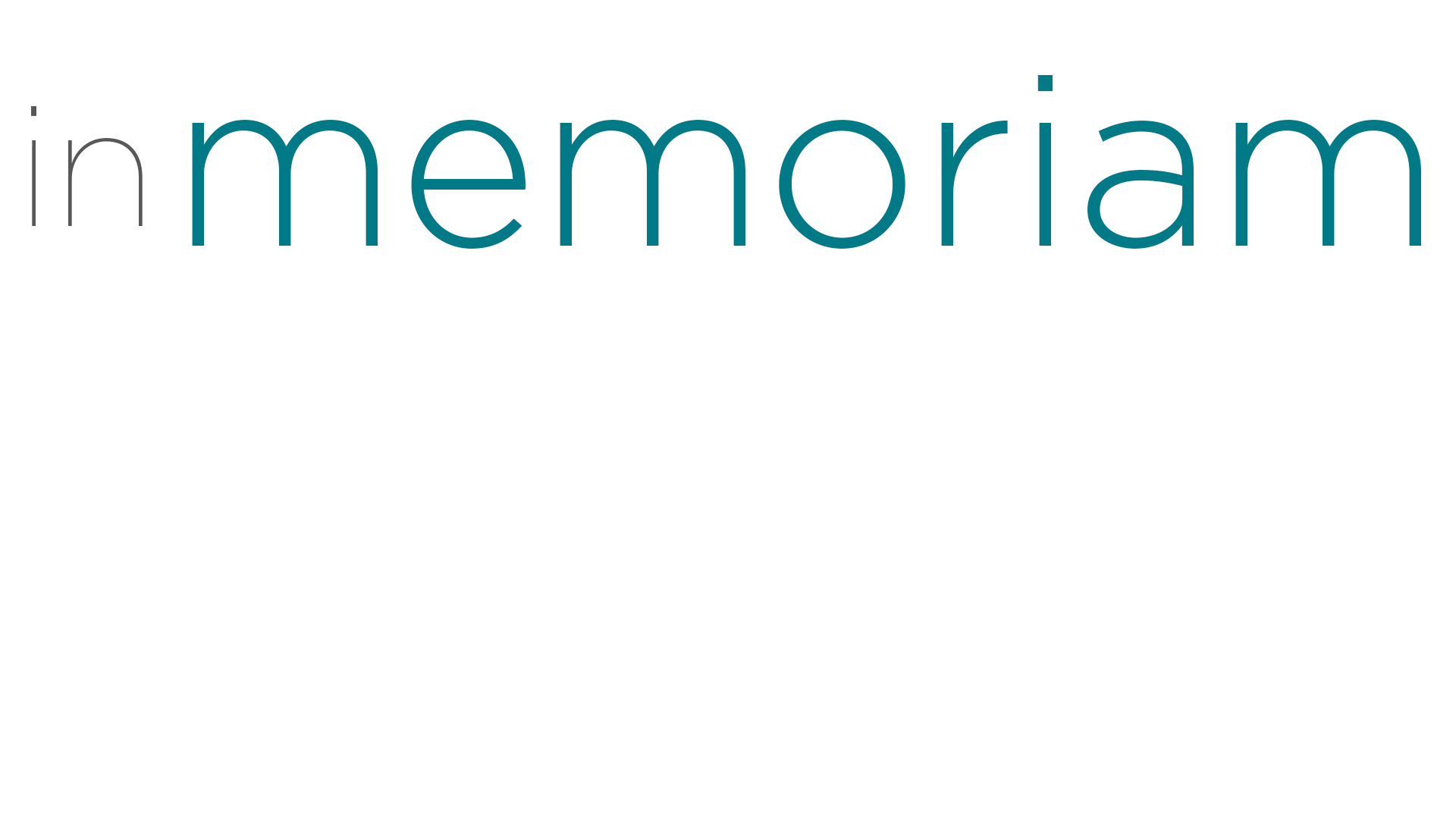
The University of New Mexico School of Medicine extends our sincere sympathies to the loved ones of our departed alumni and faculty.
To submit information on a departed member of our alumni or faculty, email us at unmsomalumni@salud.unm.edu or call 505.272.5112
UNM School of Medicine
Office of Advancement & Alumni Relations
READ
MORE
CLOSE
IN MEMORIAM
To submit information on a departed member of our alumni or faculty, email us at unmsomalumni@salud.unm.edu or call 505.272.5112
UNM School of Medicine
Office of Advancement & Alumni Relations
Alumni
Vernon James Barney, MD ’91 (Resident – Anesthesiology), passed away on July 27, 2022, in the arms of his wife and children. He was an anesthesiologist at Grant Medical Center in Columbus, Ohio, for 23 years and three years prior at the Phoenix Indian Medical Center in Phoenix, Ariz. Following medical school at UNM, he completed an internship in Oklahoma and his anesthesia residency at The Ohio State University. He cherished his children Olivia and Gabriel and loved spending time with them and seeing them grow and mature to the young adults they are today.
Michael P. Finnegan, MD ’71, (Resident – Obstetrics & Gynecology), passed away on May 28, 2022, surrounded by his loving family. He is survived by his wife Laurie and children Kelly Riley (Matt) and Michael M. Finnegan.
Margaret Fillmore Gaines, MD ’84, passed away on Aug. 16, 2022, after more than a year's struggle with pancreatic cancer. After graduating from the UNM School of Medicine, she completed her internship and residency in Rochester, N.Y., where she met her partner and later wife, Dr. Mary Jane Lambert. They moved to Seattle after residency, where Gaines completed a geriatrics fellowship at the University of Washington. She worked in primary care, geriatrics and hospice settings over the following 34 years.
John Clifford Henry, MD, ’79, passed away on May 26, 2022, at Covenant Medical Center in Lubbock, Texas. He met his wife, Glenda, while they attended Texas Tech University and married when he was a first-year medical student at UNM in 1975. Upon finishing his dermatology residency in 1983 at the University of Texas Medical Branch in Galveston, Texas, they moved to Roswell, N.M. He practiced medicine there for 36 years before retiring in March 2019.
Kenneth Mackey Ogilvie, MD ’81, has died. He wrote his own obituary: “I was happy to be known by several nicknames, including Mac, Ken, Doc, Dad, Granddaddy and Cuz. I was preceded in death by all my ancestors, and survived by all my descendants. That's lucky all by itself . . . While working full time, I started college all over again – biology and chemistry from scratch. To my own amazement, I did very well, and was accepted to med school, did well, and found myself in a top-notch residency program . . . [T]here was a patient almost every day who left a powerful, emotional memory. Thank you all for blessing my life with your trust and your life lessons.”
Elizabeth Ortiz Palmer, MD ’87, (Resident – Internal Medicine/Cardiology), passed away on Nov. 22, 2021. As a teenager, she moved to Albuquerque, where she attended Del Norte High School. At UNM she majored in chemistry and joined the Kappa Kappa Gamma sorority before gaining early acceptance to the UNM School of Medicine. She remained at UNM for her residency in internal medicine and served an additional year as chief resident. She later completed a fellowship in cardiology and a sub-fellowship in interventional launch at the University of Utah. She returned to New Mexico, where she helped build the Heart Hospital of New Mexico. She is survived by daughters Maddie and Brooke.
Lexey Parker, MD ’76, passed away on June 26, 2022. She spent her formative years in Salt Lake City before moving to Reno, Nev. She became a member of the second class of the University of Nevada School of Medicine and completed medical school at the University of New Mexico, where she graduated with honors She went on to complete her residency in obstetrics/gynecology at the University of Arizona in 1980. She opened her OB/GYN practice in Reno in 1980. She married Lance Parker in 1970 and together they had their only child, Jennifer S. Parker, in 1980.
House Staff Alumni
A memorial service was held for Rebecca Adler, MD (Resident – Hospice and Palliative Medicine). She served as the associate chief of staff for the Geriatrics & Extended Care Service Line for the New Mexico Veteran’s Affairs Health Care System
Catherine T. Baca, MD (Resident – Family Medicine), passed away on April 13, 2022, after a seven-year illness. Her sons and husband were with her at home when she died.
Rolf Julius Kolden, MD (Resident – Psychiatry), passed away peacefully in Winthrop, Wash., on Dec. 5, 2021, with his wife and daughter by his side. He worked in New Mexico for the Indian Health Service. He transitioned from primary care to psychiatry when he realized how much time he spent talking with patients about their mental and emotional health, and he completed a psychiatry residency at UNM. Peggy and Rolf were married in 1980 in Albuquerque, and their daughter Nell was born in 1984. In 1987, they moved to Seattle, where he worked for the Veterans Affairs Health System in the drug and alcohol unit and in private practice. He also worked in the psychiatric unit of the Monroe Correctional Complex in Monroe, Wash., and later at the Community Psychiatric Clinic in Downtown Seattle.
William P. Reed, MD (Resident - Internal Medicine/Infectious Disease), passed away on May 24, 2022. He graduated from Harvard University (1955) and Harvard Medical School (1959), followed by an internship at The George Washington Hospital in Washington, D.C. He married Ellen Hill in 1957 and was drafted into the Army, then completed a three-year residency in internal medicine at Madigan Hospital at Fort Lewis, Wash. He moved to Zama Base in Japan as chief of Medicine at Sagamihara Military Hospital, where he served three. He later moved to New Mexico, completed a two-year fellowship in infectious disease, and joined the Veterans Affairs hospital and the UNM School of Medicine staff as professor of Infectious Disease. He was appointed associate chief of staff for research in 1974 and served as interim associate dean of research at in 1999. He was a member and then chairman of the Institutional Review Board at UNM for many years.
Gerald Peter Rodriguez, MD (Resident/Rotating Internship), passed away on Nov. 6, 2021. Gerald was born in Española, N.M., and graduated the Española public schools and The University of New Mexico. He completed his medical degree at the University of California, San Francisco. Following his residency at UCSF, he served as a major in the U.S. Army Medical Corps for two years. He then settled in Santa Fe with his family, where he established a private practice in obstetrics & gynecology from 1973 to 1999. He fully retired from medicine in 2009 after serving countless patients from Northern New Mexico.
Jerry Swaney, MD (Resident/Rotating Internship), passed away on July 1, 2022. He completed his University of New Mexico internship at Bernalillo County Medical Center. He was ordered into the U.S. Army Medical Corps and completed a residency in pediatrics and oncology at the University of Michigan in Ann Arbor. He accepted a fellowship in pediatric oncology-hematology at MD Anderson Cancer Institute in Houston and went on to serve as co-chair of the Pediatric Hematology/Oncology Department at Children’s Hospital in Chicago, where he would remain until he returned to Houston for a fellowship in adolescent medicine. He later worked in El Paso as a private physician, where he and his wife, Patricia, contributed to the welfare of children and their families by helping found the Candlelighters of El Paso and various other support systems for children with cancer.
Richard Warren Sauerman, MD (Resident – Obstetrics & Gynecology/Rotating Internship), passed away surrounded by his family on April 28, 2022. After graduating from the University of Illinois Medical School, he served his OB/GYN residency at The University of New Mexico and then worked for the Indian Health Service on the Zuni Indian Reservation. His OB/GYN career then began in earnest in Albuquerque, where he brought more than 5,000 babies safely into the world over 50 years of practice. He is survived by his beloved wife, Barbara Sauerman. Together, they created a wonderful life for their three children, Becky Sauerman-Miller, Rick Sauerman and Mark Sauerman, and nine grandchildren, all of whom are residents of Albuquerque.
Floyd Thomas, MD (Resident – Family Medicine), passed away peacefully in his home on May 4, 2022, with his son, Lee, by his side. As a family practice physician, he was a pillar in the medical community, practicing in Albuquerque, Farmington, Tularosa and Belen before retiring in 2018. He graduated from the University of Arizona and was the first Hopi Indian to become a physician. He completed his residency at UNM . He enjoyed golfing, tennis, camping, fishing, reading and having fun with his son and wife Leigh, who passed in 2019. He really enjoyed being a doctor, giving true bedside manner and listening to his patients.
Dr. Jurgen Heinz Upplegger, MD (Resident – Pediatrics), passed away surrounded by family on April 14, 2022. He began studying medicine in Germany at the University of Mainz, where he graduated in 1963. He then continued his studies at the University of Zurich, the University of Freiburg in Breisgau, and in hospitals in Munich and Stuttgart. He then came to Albuquerque for his pediatric residency at The University of New Mexico in 1969. After residency he worked for the Indian Health Service in Gallup providing care to families across western New Mexico. He married Bonnie Livermore in 1983 and started a private pediatric practice in Albuquerque. After serving the children of New Mexico for 46 years, he retired in 2015.
Faculty
Dr. Thomas I. Baker, MD (Microbiology), passed away at his home.
James Cyril Drennan, MD (Orthopaedics & Rehabilitation), passed away peacefully on June 7, 2022, at home in Albuquerque with his three children by his side. His initial academic position was at the University of Colorado in Denver from 1971 to 1974. Then he moved to Newington Children's Hospital in Connecticut, where he was the director of Orthopedics until 1987. He moved to Albuquerque to become medical director and CEO of Carrie Tingley Children's Hospital at UNM. He retired in 2001, but he continued to see patients in the Lovelace Health System for an additional five years. He belonged to the American Academy of Orthopedic Surgeons, the Pediatric Orthopedic Society and the New Mexico Orthopedic Association and also served as a member of the board of trustees for the Sandia Preparatory School.
Jan Alan Fawcett, MD, (Psychiatry & Behavioral Sciences), died on May 9, 2022, after a long health struggle. At 38, he became one of the youngest people ever to chair a department of psychiatry, when he went to Rush Medical College, a position he held for 30 years. He built a department with a robust research output, encouraging faculty to study anything that might improve lives. He moved to Santa Fe in 2002, and worked part-time as a professor at UNM, where he established a clinic for patients with treatment-resistant depression and mentored trainees and young faculty.
Charles Andrew Kelsey, MD (Radiology), passed away on Jan. 24, 2022, after a brief illness. He graduated from St. Edward’s University in Austin, Texas, and received his PhD in nuclear physics from the University of Notre Dame. He was a professor of Radiology and Physics at the University of Wisconsin, Madison, before joining UNM in 1975, where he was a professor of Radiology and Physics until his retirement in 2002.
Steven Alan Seifert, MD, FACMT, FACEP (Emergency Medicine), passed away on May 18, 2022 in Albuquerque. He graduated from Cornell University in 1972, from the University of Cincinnati College of Medicine in 1976, and interned in family practice at the University of Arizona in 1977. In 1999 he completed a fellowship in toxicology from the University of Colorado Rocky Mountain Poison and Drug Center and served as medical director of the Nebraska Regional Poison Control Center from 2003-2007 and later, the New Mexico Poison & Drug Information Center from 2007-2022. He also served as editor-in-chief of the journal Clinical Toxicology, and co-founded Venom Week, an interdisciplinary scientific conference on venomous animals, their venoms, and the management of envenomations. He was honored with the American College of Medical Toxicology's Ellenhorn Career Achievement Award in 2022. He was jazz tenor saxophone player, a black belt in Tae Kwon Do, a frequent rider of the 100-mile El Tour de Tucson bike race and a writer/poet.
CLOSE
BACK STORY: Homeward Bound
By Nikifor Konstantinov, MD, Assistant Professor, Department of Dermatology
One of my favorite things on a long drive is to tilt my seat ever so slightly back, drink a cup of vanilla-hazelnut coffee and turn on some acoustic classics.
On the 20-hour drive from Minnesota to New Mexico, I played one of my favorite songs, “Homeward Bound,” by Simon and Garfunkel. It has a nice chorus that resonated with me on my journey back.
Homeward bound,
I wish I was homeward bound,
Home where my thought’s escaping
Home where my music’s playing,
Home where my love lies waiting silently for me.
Six years ago, I left Albuquerque for my dream residency, a combined internal medicine and dermatology program at the University of Minnesota. This seemingly good news occurred at a difficult point in my life, and I wasn’t sure I would want to return to New Mexico.
Over time, however, my journey rekindled my desire and commitment to practice medicine here. My return as an assistant professor of Internal Medicine and Dermatology at UNM has given me a sense of pride, joy and excitement for the future.
I am not the traditional New Mexico resident. I am a Bulgarian-American, born in Copenhagen, Denmark.
I grew up in San Diego and New York and moved to New Mexico in the eighth grade. After high school, I was accepted into UNM’s combined BA/MD Degree Program, which has a mission of educating and retaining health care providers for the state.
Early on, I never felt especially attached to practice in New Mexico. My desire to practice here came much later and was slowly cultivated due to a variety of experiences. There are many reasons for this change, but mentorship during my early medical career was particularly important.
A key step for a successful career is finding good role models and mentors. I kept my experiences diverse in medical school in order to learn different approaches and perspectives in medicine. I volunteered for years in a cancer epigenetics lab under Prof. Mary Ann Osley.
Dr. Antonios Tzamaloukas, professor emeritus in Nephrology, showed me the importance of scholarly research in medicine. My interest in inpatient medicine peaked when I did a rural rotation under a great internist, Dr. George Laws, in Alamogordo, N.M.
All these experiences and mentors helped pave a route and shape my interest in my career even today.
My time at the University of Minnesota was no different. I found fantastic teachers and mentors who supported my academic interests. I eventually discovered a nice fusion between my two specialties in complex medical dermatology and autoimmune skin disorders.
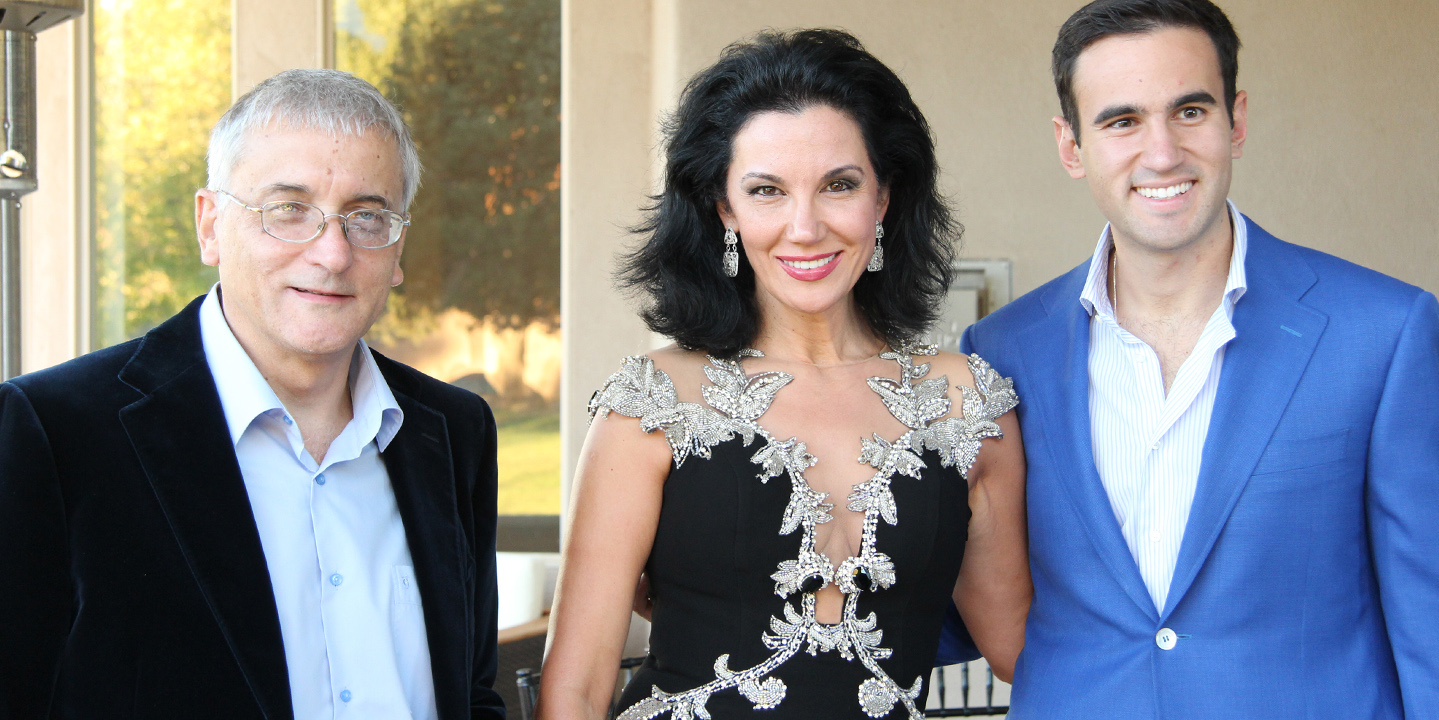 My parents have also been a source of inspiration and my strongest supporters during my early career – my father, a professor in Rheumatology and Dermatology, who practices in Albuquerque, and my mother, Teodora “Tedi” Konstantinova, who was a beloved hospitalist at the Veterans Affairs Medical Center in Albuquerque.
My parents have also been a source of inspiration and my strongest supporters during my early career – my father, a professor in Rheumatology and Dermatology, who practices in Albuquerque, and my mother, Teodora “Tedi” Konstantinova, who was a beloved hospitalist at the Veterans Affairs Medical Center in Albuquerque.
My mother loved New Mexico and was dedicated to providing excellent clinical care to her patients.
Furthermore, she valued the importance of medical education and teaching. Her students and residents adored her. She was always dressed like a movie star – even at work – and emitted an incredible positive aura around her. Stories have circulated that some of her patients thought they were already in heaven when they would see her round in the morning. When I rotated at the VA as a third year medical student, she would step across the hall to watch me present my patients to my attending physician. Her eyes were filled with pride. I remember even feeling embarrassed around my peers.
In my last year of medical school, my mother was killed on a hit-and-run car crash on her way to work just after New Year’s 2016. I saw her draw her final breaths at the UNM Hospital intensive care unit despite heroic efforts by her medicine team to save her. For my father and me, medicine at that moment became secondary and the desire to find the truth and justice was primarily on our minds. My mom, whose biggest desire was to see where my career would take me, never found out where I matched for residency.
Any hopes about sharing future life achievements with her died that day as well.
Her tragic loss took a great toll on our family, but over time her example motivated me to work toward becoming a better and more compassionate physician. This experience made me able to relate better to patients and their families during their most vulnerable and worst moments. In a sense, I also wanted to continue her legacy of excellent patient care in New Mexico through me.
Seeing both of my parents’ commitment to improve health care in New Mexico no doubt has played some role in my desire to do the same.
But it’s not just that. We have the most wonderful patient population, a great need for medical providers and enormous social inequities that need significant work and improvement. It has been my pleasure and honor to return to a great team at UNM.
Practicing medicine in New Mexico is not for the faint of heart – it is challenging – but at the same time incredibly interesting, exciting and rewarding.
LET'S GIVE OUR NEW DEAN A GREAT START
Support the School of Medicine
Dean's Excellence Fund
At the discretion of the Dean of the School of Medicine, the School of Medicine Dean's Excellence Fund provides resources for the dean to support projects and programs important to the mission, vision and values of the School of Medicine.
GIVE ONLINE
READ
MORE
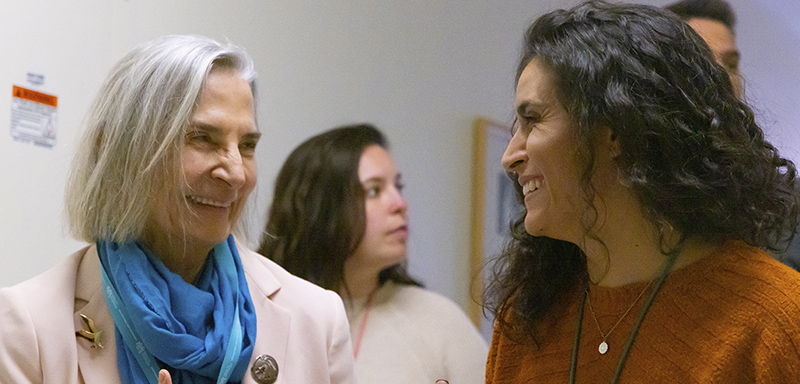
CLOSE
LET'S GIVE OUR NEW DEAN A GREAT START
Support the School of Medicine
Dean's Excellence Fund
At the discretion of the Dean of the School of Medicine, the School of Medicine Dean's Excellence Fund provides resources for the dean to support projects and programs important to the mission, vision and values of the School of Medicine.
GIVE ONLINE
To submit story ideas, please contact unmsomalumni@salud.unm.edu
EDITORIAL BOARD
Editor-in-Chief: Michael Haederle
Creative Director: Bridgette Wagner Jones
Managing Editor: Ashley Salazar
Dean's Office: Patricia W. Finn, MD
READ
MORE

CLOSE
To submit story ideas, please contact unmsomalumni@salud.unm.edu
EDITORIAL BOARD
Editor-in-Chief: Michael Haederle
Creative Director: Bridgette Wagner Jones
Managing Editor: Ashley Salazar
Dean's Office: Patricia W. Finn, MD
Contributing Writers
Elizabeth Gibson, Michael Haederle, Bridgette W. Jones, Nikifor Konstantinov, Sageline LaBaze, Makenzie McNeill, Emily Monteiro Morelli, Ruth Morgan, Paige R. Penland, Ashley Salazar, Maggie Schold
Photography
Jett Loe, Andrew Roibal, Raymond Mares, Allan Stone
Graphic, Print and Digital Design
Bridgette Wagner Jones

